

|
| articles | forbidden stories I-State Lines resources my hidden history reviews | home | ||

Writing/Film Dear Aspiring Writers: The Worst Advice You'll Ever Read A Literary Look at I-State Lines Spirited Away: Decay and Renewal An American Poem (Robinson Jeffers) Taoist Chinese Poems The Nelson Touch "It's all about oil, isn't it?" Kurosawa's High and Low A Bountiful Mutiny Howl's Moving Castle Thailand's Iron Ladies Trois Colours: Red The Thin Man: Thoroughly Modern Movies Why My Book Is Better Than the DaVinci Code 9 more in archive Recommended Books American Identity Hapas: The New America Can You Tell What I am? Part I Can You Tell What I am? Part II Only in America Self-Reliance Your Tattoo in 50 Years Cultural Commentaries On Hatred and Anti-Americanism Anti-Americanism Part 2 Anti-Americanism Part 3 French-Bashing Germany: We All Have Problems, But... Kroika! Chronicles This Blog Sells Out Doom and Gloom Sells The Kroika Mascot-"Auspicious Pet" Wal-Mart and Kroika Kroika and Starsbuck Take a Hit Kroika Ad 1 Kroika Ad 2 Kroika Ad 3 Kroika Ad 4 Kroika Makes Bid for Oreo (April 1) Unfolding Crises: Asia China: An Interim Report Shanghai Postcard 2004 Corruption and Avian Flu: China's Dynamic Duo Exporting the Real Estate Bubble to China Is the Bloom Off the China Rose? China Irony: Steel, Marx & Capital Curing The U.S. and China's Dysfunctional Relationship China and U.S. Inflation Trade with China: Making Out Like a Bandit 8 more Battle for the Soul of America Katrina, Vietnam, Iraq: National Purpose, National Sacrifice Is This a Nation at War? A Nation in Denial Why Is This Such a Tepid Time? That Price Isn't Cheap, It's Subsidized U.S. Fascists Seek Ban on Cancer Vaccine The Truth About Christmas American Dream or American Nightmare? The Most Hated Company in America 2006 Sea Change Obesity and Debt Immigration Ironies 10 more Financial Meltdown Watch What This Country Needs Is a... Good Recession Are We Entering the Next Age of Turmoil? Why Inflation Appears Low Doubling Down on 5-Card No-See-Um A Rickety Global House of Cards Are Japan and Germany Truly on the Mend? Unprecedented Risk 2 Could One Rogue Trader Bring Down the Market? Worried about Inflation? Stop Measuring It Economy Great? Bah, Humbug Huge Deficits and Huge Profits: Coincidence? Who's The Largest Exporter? Three Snapshots of the U.S. Economy Loaded for Bear Comparing Nasdaq to Depression-Era Dow Who's Buying Treasury Bonds? And Why? Derivatives: Wall Street Fiddles, Rome Smolders 31 more Planetary Meltdown Watch The Immensity of Global Warming Sun Sets on Skeptics of Global Warming Housing Bubble Watch Charting Unaffordability A Monster of a Housing Bubble A Coup de Grace to the Economy Hidden Costs of the Housing Bubble Housing Bubble? What Bubble? Housing Bubble II Housing Bubble III: Pop! Housing Market Slips Toward Cliff Housing Market Demographics Housing: Catching the Falling Knife Five Stages of the Housing Bubble Derailing the Property Tax Gravy Train Bubbling Property Taxes Have You Checked Your Property Taxes Recently? Housing Bubble: Where's the Bottom? Housing Bubble: Bottom II The Housing - Inflation Connection The Coming Foreclosure Nightmare 1 The Coming Foreclosure Nightmare 2 4 more Oil/Energy Crises Whither Oil? How much Is a Gallon of Gas Worth? The End of Cheap Oil Natural Gas, Naturally High Arab Oil Money and U.S. Treasuries: Quid Pro Quo? The C.I.A., Oil and the Wisdom of Crowds The Flutter of a Butterfly's Wings? A One-Two Punch to a Glass Jaw 2 more Outside the Box How to Make a Favicon Asian Emoticons In Memoriam: Winky Cosmos The Wheeled Vagabonds Geezer Rock Overload In a Humorous Vein If Only Writers Had Uniforms Opening the Kimono Happiness for Sale: Jank Coffee Ten Guaranteed Predictions for 2010 Why My Book Is Better Than the DaVinci Code Design Follies The New Jank Coffee Shop Jank Coffee, Upscale Tropic Style One-Word Titles Complacency Nostalgia Praxis Keys to Affordable Housing U.S. Conservation & China Steve Toma, Me & Skil 77s: 30 years of Labor Real Science in the Bolivian Forest Deforestation and Sustainable Forestry The Solar Economy (book) The Problem with Techno-Fixes I Love Technology, I Hate Technology How To Blow off Web Ads and More 2 more Health, Wealth & Demographics Beauty of the Augmented (Korean) Kind Demographics and War The Healthiest Cold Cereal: Surprise! 900 Miles to the Gallon Are Our Cities Making Us Fat? One Serving of Deception Is Obesity an Inflammatory Response? Demographics & National Bankruptcy The Decline of Europe: A Demographic Done Deal? Are the Risks of Obesity Overstated? Healthcare: Unaffordable Everywhere 1 more Landscapes Selling the Landscape The Downside of Density Building Heights and Arboral Roots Terroir: France & California L.A.: It's About Cheap Oil The Last Redwood Airport Walkabouts Nourishment The French Village Bakery Ideas What Is Happiness? Our Education System: a Factory Metaphor? Understanding Globalization: Braudel Can You Create Creativity? Do Average People Know More Than Their Leaders? On The Impermanence of Work Flattening the Knowledge Curve: The "Googling" Effect Human Bandwidth and Knowledge Iraqi Guangxi Splogs, Blogs and "News" "There is no alternative to being yourself" Is There a Cycle to War? Leisure, Time and Valentines Is the Web a Giant Copy Machine? History The Strolling Bones: Rock of Ages Bad Karma: Election Fraud 1960 Hiroshima: First Use All the Tea in China, All the Ginseng in America Friday Quiz Pet Obesity The Origins of Carbonara Organic Farms Oil and Renewable Energy Human Diseases Wine and Alzheimers Biggest Consumers of Chocolate 7 more Essential Books The Misbehavior of Markets Boiling Point (Global Warming) Our Stolen Future: How We Are Threatening Our Fertility, Intelligence and Survival How We Know What Isn't So Fewer: How the New Demography of Depopulation Will Shape Our Future The Coming Generational Storm: What You Need to Know about America's Economic Future The Third Chimpanzee: The Evolution and Future of the Human Animal The Future of Life Beyond Oil: The View from Hubbert's Peak The Party's Over: Oil, War and the Fate of Industrial Societies The Solar Economy: Renewable Energy for a Sustainable Global Future The Dollar Crisis: Causes, Consequences, Cures Running On Empty: How The Democratic and Republican Parties Are Bankrupting Our Future and What Americans Can Do About It Recommended Books More book reviews Archives: weblog April 2006 weblog March 2006 weblog February 2006 weblog January 2006 weblog December 2005 weblog November 2005 weblog October 2005 weblog September 2005 weblog August 2005 weblog July 2005 weblog June 2005 weblog May 2005 What's New, 2/03 - 5/05 
|
May 31, 2006 Whither China?  Will China be hurt as the U.S. housing bubble bursts, triggering a recession? And why
should we care?
Will China be hurt as the U.S. housing bubble bursts, triggering a recession? And why
should we care?
We should care for a number of reasons, chiefly those of blatant self-interest. We depend on China (among others) to use their surplus dollars to buy our Treasury bonds (regardless of low yield and high risk of a decline) to keep our interest rates low. If the Chinese have fewer surplus dollars--i.e., our recession causes their exports to us to plummet-- then that also means they'll be buying fewer Treasuries. Once the willing buyers vanish, then interest rates will have to rise to entice less-willing buyers. And as everyone knows, higher interest rates mean higher mortgage rates, which will only speed up the global real estate bubble's collapse. There seems little doubt that China will be hurt by a U.S. recession. While some have argued that China's domestic market is large enough that they don't need exports, this view ignores two important factors of macro-economic growth: as Braudel documented in his massive three-volume history of capitalism, The Structures of Everyday Life (Volume 1 of Civilization & Capitalism) 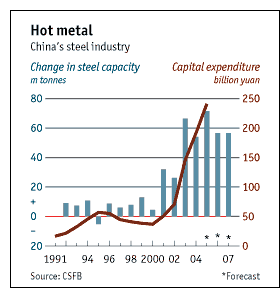 On my first visit to China in 2000, the official English-language paper carried numerous
stories describing a massive over-capacity glut in domestic television production;
tremendous overproduction of TV sets had led to lower consumer prices and huge losses for
the producers. So yes, the Chinese can make goods for their domestic market, but they
can't sell them at a profit, for the reasons (ironically, perhaps) Marx outlined. As
this chart reveals, the Chinese are busily creating massive over-capacity in steel,
automobiles and many other key industries, aided by gigantic inflows of foreign capital.
On my first visit to China in 2000, the official English-language paper carried numerous
stories describing a massive over-capacity glut in domestic television production;
tremendous overproduction of TV sets had led to lower consumer prices and huge losses for
the producers. So yes, the Chinese can make goods for their domestic market, but they
can't sell them at a profit, for the reasons (ironically, perhaps) Marx outlined. As
this chart reveals, the Chinese are busily creating massive over-capacity in steel,
automobiles and many other key industries, aided by gigantic inflows of foreign capital.
For more, please read China Irony: Steel, Marx and Monopoly Capital. The other reason China needs Western partners is for capital. Up to 40% of their entire GDP is foreign investment--factories, high-rises, you name it. As the bursting housing bubble reduces American consumer's profligate borrowing and spending, then why would anyone pour additional billions into making new factories in China? Once foreign investment dries up, so will the Chinese sectors which depend on huge inflows of foreign capital. As for the Chinese real estate market: sadly, the rest of the world exported their bubble to China. Experienced analyst Andy Xie expects a hard landing in China properties values, and there is little evidence that the government is successfully reining in the vast speculative building of luxury properties. The problem is structural; while the central government is theoretically in charge of everything, the actual administration is left in the hands of local authorities-- the same authorities who are beholden to growth at any price and who are famously corrupt. The consequence is that central government policies are rarely enforced, in either economic or environmental policies. So the government announces yet another Yangtze River clean-up campaign but few expect any real action to result because the clean-up depends on local authorities with other things on their minds--such as getting rich and enabling their region to get rich.  The structural flaw in the Chinese financial system relates not to local authority but
the peculiar way the government has funded employment. Rather than tax productive assets
and people, China has funded its notoriously money-losing government factories by taking
the savings of its citizenry and lending that money to the factories through its four
State-owned banks. As the factories
continue to lose money, new loans are made; the alternative is to close the factories and
suffer mass unemployment, which has occurred in the industrial north. Despite such large-scale
lay-offs, about 40% of the workforce still labors for a government-owned enterprise.
The structural flaw in the Chinese financial system relates not to local authority but
the peculiar way the government has funded employment. Rather than tax productive assets
and people, China has funded its notoriously money-losing government factories by taking
the savings of its citizenry and lending that money to the factories through its four
State-owned banks. As the factories
continue to lose money, new loans are made; the alternative is to close the factories and
suffer mass unemployment, which has occurred in the industrial north. Despite such large-scale
lay-offs, about 40% of the workforce still labors for a government-owned enterprise.
Factories that remain open are still drawing new loans which will never be paid back; and what's left of the closed factories is hundreds of billions in bad debt. The government throws $50 billion or so to reduce the debt every now and again, but this doesn't reform the system; it just keeps the still-growing bad debt down to managable levels. As China shifts to a system of tax collection, they might be able to wean themselves off this bizarre system of loaning savings out, never to be repaid, in lieu of public spending; but the tax collection system is young and already corrupted; some pay, most don't. A recent estimate of China's bad debt at $919 billion drew a chilly official response and was promptly withdrawn-- excellent evidence that it was accurate or perhaps even low: China's bad debts. The reason is, of course, that the Chinese government is very much into managing perceptions; this plays out in myriad ways, such as ignoring the cultural revolution as an embarrassment (like bad debt) better left obscured from public scrutiny. If everything which doesn't fit into the official propaganda is suppressed, then how can anyone be confident that bad debt, or indeed, any data, is even close to reality? And if you don't have any real data, how can you make good decisions? That doesn't bode well for either the Chinese government or the foreign investors gambling on its officially burnished future. For more on these topics, please read China and the U.S.: Curing a Dysfunctional Fiscal Relationship and China: An Interim Report: Its Economy, Ecology and Future. May 30, 2006 The Growing Financial Risks of the Housing Bubble 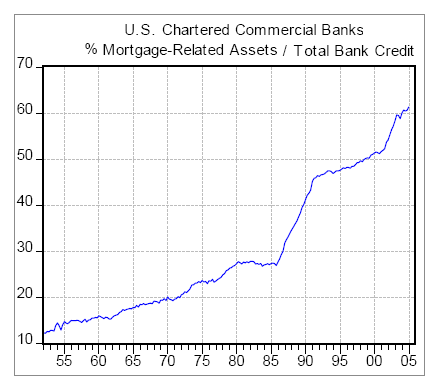 This is not your father's housing market or indeed, his mortgage market. The imbalances,
and thus the risks, of the housing bubble have spread into our entire financial system.
This is not your father's housing market or indeed, his mortgage market. The imbalances,
and thus the risks, of the housing bubble have spread into our entire financial system.
How so? Let's start--and end--with mortgages, leverage, derivatives and debt. First up is the chart showing that mortgages have grown to about 2/3 of banks' total credit portfolios. Note how this is up from less than 30% twenty years ago. This isn't just a measure of their mortgage exposure; it's also a measure of their exposure to risk in the credit market should a decline in the housing market trigger a rise in non-performing loans--i.e., people squeezed by ARM re-sets or rising debt loads to the point they are unable to keep current on their mortgage payments. 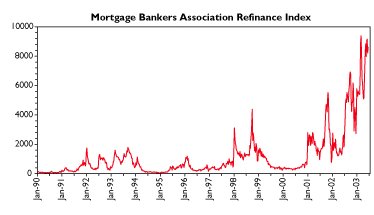 A very knowledgeable reader who prefers to remain anonymous recently encapsulated some of
the other risks inherent in the current housing and lending markets. His first point: the extreme
downside risk inherent in highly leveraged real estate:
A very knowledgeable reader who prefers to remain anonymous recently encapsulated some of
the other risks inherent in the current housing and lending markets. His first point: the extreme
downside risk inherent in highly leveraged real estate:
Your recent posting about the significance of a 10% decline is certainly right on the mark. What's interesting is that people don't think about the fact that in the stock market 10% volatility is nothing, but that's because margin accounts limit leverage of retail investors to 50%. In the housing bubble, 10% volatility is HUGE because there are so many investors leveraged to 100% (or more). Even those without interest only or negative amortization loans who HELOC'd (home equity line of credit) are at huge risk, especially since home equity is such a large part of people's retirement plans.This contributor noted the psychological impact of the tax policy which rewards people for flipping their primary residence every few years--and the rise of mortgage-backed securities and derivatives: Another topic of interest I don't see get much press as a driver of the housing bubble relates to the tax free treatment of the first $250K or $500K in gains on a primary residence. Although there's much press on how our government spurred the housing bubble with a liquidity bail out based on money supply and cuts in interest rates, I think the effect of these tax credits are hugely underestimated in terms of a wholesale change in American "investment psychology". An additional driver I would suggest which also gets little press is the massive proliferation of derivatives by financial institutions to off load and disperse mortgage loan risk and the lax regulatory environment promoted by the prior and current Fed. 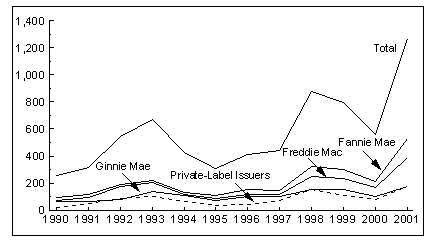 A bit of history is necessary here. In the good old days, local banks would actually
retain the mortgages they underwrote, collecting the interest and principal as an integral
part of their portfolio of assets and their income stream. This is now as quaint as buggy
whips. Lenders quickly sell any mortages they underwrite to large banks which just as quickly
aggregate hundreds of millions of dollars of mortgages into "mortgage backed securities"--in
effect, turning mortgages into securities which can be traded like bonds. As the
chart reveals, this practise exploded in 2000.
A bit of history is necessary here. In the good old days, local banks would actually
retain the mortgages they underwrote, collecting the interest and principal as an integral
part of their portfolio of assets and their income stream. This is now as quaint as buggy
whips. Lenders quickly sell any mortages they underwrite to large banks which just as quickly
aggregate hundreds of millions of dollars of mortgages into "mortgage backed securities"--in
effect, turning mortgages into securities which can be traded like bonds. As the
chart reveals, this practise exploded in 2000.
And like bonds, the securities can be tranched into various chunks of risk and hedged by various types of derivatives. The idea, of course, is to minimize risk by hedging with derivatives--but the explosion of derivatives has put risk management in uncharted waters. As my correspondent explains: 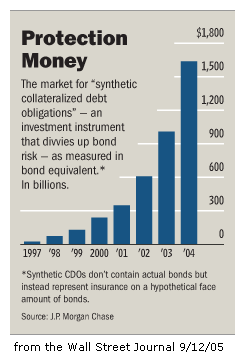
Regarding mortgage backed securities, just to be clear, there seem to be two related issues:Well said, well said. May 29, 2006 Truth in Advertising--Buying a $450K Home for $750K 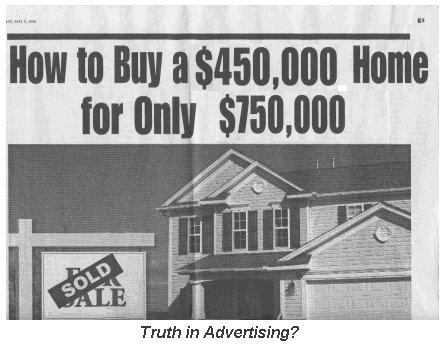
* * * * * * * * * * * * * * * * * * * * * I recently came across this ad in a major American newspaper and was struck by the "truth in advertising" which was apparently imposed on a typical real estate pitch aimed at the naive and greedy (as opposed to the experienced and greedy). The ad went on to list "The cutting-edge secrets to buying real estate at 30% to 50% above market value:" Low and behold, all the conditions have been met, and it is indeed possible to buy houses for 50% above their market value. Of course when inflation can no longer be cloaked, it will be too late to stop its further ascent--which insures mortgage rates will climb, bankrupting all those with adjustable-rate mortgages (ARMs). The massive over-supply of investor-owned units is already raising inventories around the nation, and as this trickle gorws to a mighty flood, the foreclosures of the ARM-bankrupted will also hit the markets. As lenders are inundated with losses from risky loans gone bad (surprise, sub-prime borrowers are not good risks), they will no longer be able to lend money as their reserves will have to be rebuilt even as their losses multiply. Leverage will fall off a cliff as lending standards are belatedly raised, but alas, all this will be too little, too late; the over-supply has been built, the demand has been sated, and investor-owned properties will soon be on the market. The cutting-edge secret to buying real estate at 30% to 50% below market value? It's this simple: wait a few years for the market to re-set valuations. Pretty simple, huh? Congratulations to reader Robert C. for correctly identifying yesterday's image as Taliesin West, Frank Lloyd Wright's home and studio in Scottsdale, Arizona. His (very) modest prize: a signed copy of I-State Lines. May 27, 2006 The American House and Frank Lloyd Wright  Frank Lloyd Wright did not design a housing "style;" he designed a new American identity
rooted in a landscape of democracy. In the current obsession with housing as an
investment vehicle and a ticket to gobs of free money, it's worth recalling that a house
is not just a repository of cash value or even shelter; it is also a space which nurtures or
deadens identity and either wastes or employs limited resources. Wright understood this in
a way which has largely been lost in our design-deprived era.
Frank Lloyd Wright did not design a housing "style;" he designed a new American identity
rooted in a landscape of democracy. In the current obsession with housing as an
investment vehicle and a ticket to gobs of free money, it's worth recalling that a house
is not just a repository of cash value or even shelter; it is also a space which nurtures or
deadens identity and either wastes or employs limited resources. Wright understood this in
a way which has largely been lost in our design-deprived era.
Like many other larger-than-life people, Wright was a mass of sometimes prickly or even unlikeable contradictions. Known for an almost comically monstrous ego, he nonetheless produced a body of work and a philosophy which is uniquely American in vigor, scope and depth. How egotistical, you ask? A young couple once wrote to Wright, inquiring about the cost of his services. They heard nothing for months and then received a call one day from an imperious-sounding male: "This is your architect speaking." It was pure Wright; never mind responding to the inquiry about costs; my schedule (and bank account) has been cleared, and I will now design your house, regardless of your wishes.  History has not always been kind to his buildings, either; many leak or suffer structural
problems; the
Ennis House (shown above) in the Los Feliz district of Los Angeles is in the midst of a multi-million dollar
structural rehab, and
Falling Water, perhaps Wright's most famous house, recently underwent a complex
structural renovation.
History has not always been kind to his buildings, either; many leak or suffer structural
problems; the
Ennis House (shown above) in the Los Feliz district of Los Angeles is in the midst of a multi-million dollar
structural rehab, and
Falling Water, perhaps Wright's most famous house, recently underwent a complex
structural renovation.
Given that these homes were designed and built in the 20s and 30s, before structural engineers fully understood how to calculate all the forces placed on buildings, it may be unfair to place the blame entirely on Wright's unconventional designs and construction techniques. Still, it is fair to say that his smaller, more conventionally constructed "Usonian" houses have not required the enormously expensive repairs which have plagued some of his larger, stretching-the-envelope projects.  Wright was dedicated not just to large-scale projects for wealthy clients but to a vision
of affordable, beautifully designed homes for average-income people, houses he dubbed
"Usonian" (a derivative of "U.S."). As a result, he experimented at great length with cheap,
easy-to-build materials, most notably concrete blocks, as shown here in a wall of his
La Miniatura house in Pasadena, California.
Wright was dedicated not just to large-scale projects for wealthy clients but to a vision
of affordable, beautifully designed homes for average-income people, houses he dubbed
"Usonian" (a derivative of "U.S."). As a result, he experimented at great length with cheap,
easy-to-build materials, most notably concrete blocks, as shown here in a wall of his
La Miniatura house in Pasadena, California.
One of my favorite Wright stories is his own account of discovering that ancient Chinese and Japanese artists had developed the tenets of his "organic architecture" long before he himself set pen to paper. This degradation of his genius sent Wright into a deep funk until the happy thought occurred to him that as these past masters were not alive today, he was still the world's premier torch-carrier of "organic" design. What is "organic" architecture? Simply put, it is buildings which are integrated into, and draw inspiration from, the landscape in which they are sited. Further, the home's furnishings are designed into the house itself rather than purchased willy-nilly or changed out every few years as fashion dictates. 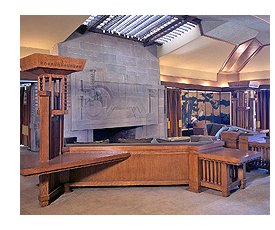 Here is an example from the Hollyhock House in Los Angeles. One of the charming features of
this living room is the small stream of water which meanders around the fireplace. On my
last visit some years ago, the rivulet of water was not running, but the concept was
dramatically and invitingly original.
Here is an example from the Hollyhock House in Los Angeles. One of the charming features of
this living room is the small stream of water which meanders around the fireplace. On my
last visit some years ago, the rivulet of water was not running, but the concept was
dramatically and invitingly original.
I cannot quite describe the profound influence these buildings had on me as a child. Can you vividly recall any houses you visited as a child? Can you relive the sense of awe and wonderment you felt? Did any house evoke such a powerful sense of mystery in you that the memory still burns hot in your mind? This is the largely unrealized power of great design; just entering a Wright house, especially a small Usonian one, is to feel welcomed and spiritually enlivened in a way which is incomprehensible to those who have known only bland, drywall-stucco-pressed sawdust-siding monstrosities. This is not an intellectual experience; it is a deeply emotional, visceral one which transforms your understanding of space and the great unrealized potential of housing to uplift the human spirit.  We lived in the Los Feliz area for several years in my childhood, and I would often gaze
up at the low, almost brooding Mayan fortress of the Ennis House. My elementary school
was located just below the
Hollyhock House, and my summer art classes
were held in the property's small guest house (circa 1963-64). As a 10-year old, I did not know about Wright,
or what made these buildings so memorably mysterious and attractive; but the buildings
work their magic perhaps more readily on children than on jaded (or more accurately, brainwashed)
adults.
We lived in the Los Feliz area for several years in my childhood, and I would often gaze
up at the low, almost brooding Mayan fortress of the Ennis House. My elementary school
was located just below the
Hollyhock House, and my summer art classes
were held in the property's small guest house (circa 1963-64). As a 10-year old, I did not know about Wright,
or what made these buildings so memorably mysterious and attractive; but the buildings
work their magic perhaps more readily on children than on jaded (or more accurately, brainwashed)
adults.
 If you are not familiar with Wright's Usonian concept, then scroll through
Matt Taylor's excellent site on Usonian houses. To quote just one paragraph:
If you are not familiar with Wright's Usonian concept, then scroll through
Matt Taylor's excellent site on Usonian houses. To quote just one paragraph:
"One comment that Mr. Wright made again and again was 'until we have an organic culture we will never have an organic architecture.' His point is that architecture is the result of the choices individuals make and it expresses the culture they make up and in turn are influenced by. The Usonian house is not just another way to “style” a building - it is about a different way of living; a way that, today, is alien to the mainstream of our American culture. The usonian way is about relating differently to the Earth, to life and to all living beings - it is an integrated, natural life-style. Sustainable, evolving, sensory, engaging - it is to be surrounded by beauty and to live in harmony."To step into a Usonian house--small, inexpensively constructed of basic materials--is to understand how far we have drifted from being a sustainable, spiritually enriching society, and how distant the McMansions and subdivisions of today are from the profoundly democratic and practical vision made real in Wright's Usonian homes. May 26, 2006 Where Is This?  Today's location, like my little novel
Today's location, like my little novel I-State Lines, is about finding one's identity within the American landscape. Like the person who designed the structure in this photo, and my protagonist Daz, I too sense a deeply enervating falseness in the standard American landscape of bloviated, pretentious McMansions with fake columns built of fake materials and inauthentic shantytown malls designed to create a false world of consumer desires. Between the cellphones glued to passengers' ears and the TV screens in the minivans, and the cooled-cocoon interiors of identical fast-food and mall outlets, the disconnect between the typical American citizen and the American landscape seems almost complete. Although it is not widely remarked upon, we humans form what can only be described as a spiritual identity with our landscape; and to the degree that we lose touch with that landscape and live in buildings utterly detached from any sense of the land they rest on, then we become, regardless of our religious faith, spiritually bereft. A novel which describes the deep relationship we establish with the landscape we live in happens (perhaps not by chance) to be one of my favorite books: The Enigma of Arrival In the U.S., I think this "siting of the soul" can be illustrated by stories of people raised on the Great Plains who find the presence of mountains disturbing. In a similar fashion, mountain-dwellers may feel out of sorts in a big-sky prairie landscape. For me, the touchstone is the Pacific Ocean. Although I have lived beyond visual range of the Pacific at times, I cannot imagine being more than a few miles from that limitless expanse of sea. For other Americans, it might be wetlands, or a river or a lake or broken canyonland or tidy orchards; but each of us locates our deepest identity within an American landscape. Now that graduation season is upon us, please consider giving a copy of my little book or Naipaul's wonderful novel (or both) to the graduates on your list. Sure, I want the sales. (Big deal, a $1 a copy; I could do better on a street corner with a tin cup.) But more important than that is the theme of the book, which is exploring the American landscape as part of the process of finding one's life work and one's identity. How does this relate to graduation? Here's what an independent bookseller, Keri Holmes, had to say about I-State Lines: "The story works on so many levels, it's hard to summarize. Summer vacationers looking for a "Road Trip" story won't be disappointed. High School and College juniors and seniors pondering their next steps will be inspired."You can order the book from Ms. Holmes' bookstore, The Kaleidoscope: Our Focus Is You which happens to be in Iowa. Though physically sited at 112 1st Avenue NW, Hampton, IA 50441 (Tel: 641-456-2787, Fax: 641-456-2809) it is available to you via the miracle of the Internet. (Shipping is free on all orders, and you can't beat that.) Or if you have an open order at amazon.com, you can of course add I-State Lines Be the first to identify the locale behind me, and I'll send you a collector's copy of my book I-State Lines. So email me! We have two winners! Emilio G. and Dan S. correctly identified the Friday "mystery park" as the Black Canyon of the Gunnison National Park in the Colorado Rockies. Congratulations, Emilio and Dan! A signed copy of I-State Lines will go to each of you. May 25, 2006 Inflation and Housing: Calculating the Bust 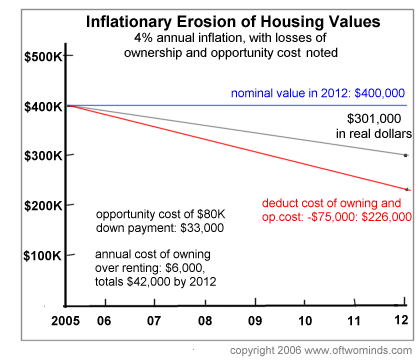 Astute reader Richard C. was kind enough to send me a link to UCLA economist
Christopher Thornberg's talk on the California housing bubble.
Astute reader Richard C. was kind enough to send me a link to UCLA economist
Christopher Thornberg's talk on the California housing bubble.
Richard described the program thusly: "Although a bit long to watch in the front of the computer (58 minutes), Thornberg's talk is a tour de force performance by a mainstream economist." I heartily concur. So what are Thornberg's conclusions? His best-case scenario: no appreciation in housing through 2011 or 2012. In other words, the house that sold in 2005 at the top for $400,000 will still be worth $400,000 in 2012. Well, you sigh; that's not too bad, right? At least they're not losing money. Alas, if only it were true. At the very modest rate of 4% inflation, the $400K house will decline to $301,000 in real dollars. Although I drew a straight line for simplicity's sake, the calculations were not straight-line. Here are the annual values after the 4% inflationary haircut: 2005: $400,000 2006: $384,000 2007: $369,000 2008: $354,000 2009: $340,000 2010: $326,600 2011: $$313,600 2012: $301,000 You might reasonably ask: if wages are keeping pace with inflation, and interest rates remain low, why wouldn't housing rise with inflation? Thornberg's answers: 1. the U.S. and yes, even California, has experienced massive overbuilding; the number of homes built has far exceeded the growth of households. This overhang will suppress prices for at least six years. 2. The end of the bubble will cause massive job losses in the very categories which have propped up the economy: building, financing and furnishing millions of new or rehabbed houses. These job losses will knock the job-prop out from under housing values. And as everyone knows, housing declines when jobs disappear. So that's why this is a best-case scenario; a worst-case scenario would be a 25% nominal decline plus the 25% real-dollar decline due to inflation. Watch the presentation, look at his charts and prepare to accept the realities he documents. OK, so the homeowner is down 25% by 2012; that's not too bad, right? But wait--we forgot about subtracting the costs of ownership and the opportunity cost. As readers have pointed out, I have under-estimated both the opportunity cost (the cost of leaving a down payment sitting in a depreciating house rather than in, say, high-yield corporate bonds paying 6% annually) and in the cost of ownership above and beyond the rental price of the same house in the same neighborhood. The proprietor of the excellent View From Silicon Valley blog wrote to explain how I had likely over-estimated the tax benefits of a mortgage deduction and under-estimated the property tax costs of owning compared to renting. In a previous example regarding a hypothetical $400,000 house purchased in 2005 with 20% down and a conventional 30-year fixed-rate mortgage of 6%, I had estimated the value of the tax write-off of mortgage interest at $6,000 and the annual net loss in owning compared to renting at $6,000. "View From Silicon Valley" noted: This ignores the standard deduction. (I think it's now close to $10K for married tax filers?) Thus, the net savings on taxes may be zero, depending on other deductions. (Admittedly, even a moderately sophisticated buyer --one who actually does the math and is depending on the mortgage interest deduction to make the buy decision work-- probably has other deductions.)Another knowledgeable reader, Wayne D., describes the opportunity costs of owning a house, and provides a careful analysis of the costs of renting vs. owning: A small, but significant point left out of your analysis is the opportunity cost lost of the $80K (down payment). That's about $4K per year at 5% interest, which should be put into any equation evaluating losses. That increases their total losses because the $80K, of course, was tied up in a losing investment when it could have been earning interest.To summarize: if the buyer of a $400,000 house in 2005 had taken a conventional mortgage of 80% and made a 20% down payment, then we have to figure the opportunity cost of that $80,000 which is "dead money" in a non-appreciating real estate market. At a very modest 5%, (you can get 6% or even 7% nowadays), the homeowner's $80,000 cash would grow to about $113,000 by 2012--a total of $33,000 in lost income they could have earned had they rented rather than owned. Given the complexities of calculating the tax benefits of mortgage interest (about $19,000 in our hypothetical example of a $320,000 fixed-rate 30-year mortgage at 6%--check calculator at MSN Money yourself to confirm) and the local costs of property taxes and insurance, I believe an estimate that it costs $500 more per month to own a $400,000 house than it does to rent an equivalent home is conservative; in much of the nation, I think $1,000 a month would be a more accurate number. This conservative $6,000 "annual cost of owning" works out to a net loss of cash in the household by 2012 of $42,000--more, of course, if that $6,000 had been placed in an account drawing 5% interest. Added to the $33,00 in opportunity cost, this household would be $75,000 poorer by 2012 than a family which had rented for those seven years. In terms of a family balance sheet, the renting family is $75,000 richer and the homeowning family is $75,000 poorer. In terms of assets and liabilities, we could deduct this loss against the family's assets--i.e. the $400,000 house. The point is simple: without significant annual appreciation, owning a house which was purchased 2004-2005 makes poor financial sense. If there isn't annual appreciation above and beyond inflation, then owning a house is, in a strictly financial sense, a bust. May 24, 2006 Running Out Of Oil Versus Running Out of Cheap Oil 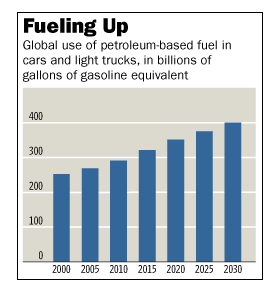 The Atlantic's senior editor Clive Crook summarized the Standard Line on oil
and energy very succinctly in the June issue:
The Atlantic's senior editor Clive Crook summarized the Standard Line on oil
and energy very succinctly in the June issue:
Much of the rhetoric about oil is overheated. The world is not running out of the stuff. With present technologies, proven and probable reserves of oil wil be sufficient for decades ... an array of existing but not widely applied technologies would make it economically feasible to extract oil from tar sands or shale, or to convert coal to liquid fuel.While Mr. Crook reaches the right conclusions in his piece, "Shock Absorption"-- he calls for energy diversification and a long-term "fix" to global warming--his grasp of petroleum realities is weak. To wit: virtually the entire substance of the above quote is utter nonsense. While Mr. Crook is no doubt a very smart guy, and his long-term view is worthy, he obviously didn't bother reading anything of value about the oil industry before he penned his breezy opinions. The realities are rather different than his opinions: 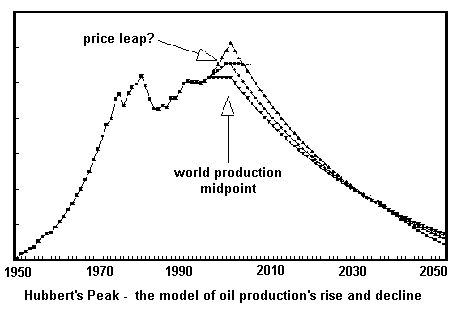
I could go on, but I'm getting tired of typing the almost limitless errors behind Mr. Crook's blithe opinions. Better for you to read Beyond Oil: The View from Hubbert's Peak. What Mr. Crook fails to divulge is that the global economy has been relying not only on oil per se, but on extremely cheap-to-pump-and-refine oil, the oil which has gushed unbidden from a handful of supergiant fields which are rapidly being depleted. Yes, there is "plenty of oil in the ground," Mr. Crook, but much of it cannot be extracted, and the rest can only be extracted at great expense. While Mr. Crook is pleased to note that the U.S. economy has withstood the effects of $50/barrel oil with no ill effects (or at least none that are visible in "official" statistics), does his hubris extend to $100/barrel or even $200/barrel oil? You know, the kind that's still left in the ground? Mr. Crook's ignorance is not just stupendously absymal, it is willful and therefore inexcusable in the age of the Web search. I also wonder if Mr. Crook would be so smarmily confident in the ease with which oil will flow to the tanks of airliners and vehicles if he lived in, say, West Virginia, near the coal strip mines he so cheerily assumes will provide him with gasoline, or the square miles of Canadian tundra being torn up and destroyed for his "economical" tar-sands oil "fix." I am rather confident that Mr.Crook resides in the safe and clean cocoon of the Upper West Side or an equivalent haven of the well-heeled--the very population who would not be too bothered by high energy costs. Sadly, Mr. Crook printed his utterly irresponsible opinions without the slightest shred of research or knowledge. Too bad he wasted such a widely read media forum for unsupported rubbish which only furthers the American public's profound ignorance of the energy complex which fuels their soon-to-be-very-expensive lifestyle. May 23, 2006 U.S. Healthcare: Working Toward a Real Solution 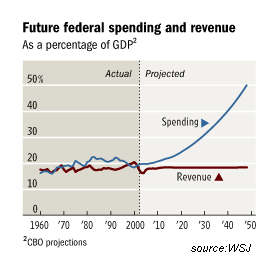 As this chart so chillingly illustrates, healthcare as currently configured in this
country will drive us into national bankruptcy. (All that future Federal spending
is largely Medicare and Medicaid.) We as a nation need a solution soon--
and not a solution delivered by poo-bahs in think tanks or the healthcare lobby
(oops I meant to say "Congress"), but a solution which can be understaood and embraced by
those who will have to live with it, i.e. us, the citizenry.
As this chart so chillingly illustrates, healthcare as currently configured in this
country will drive us into national bankruptcy. (All that future Federal spending
is largely Medicare and Medicaid.) We as a nation need a solution soon--
and not a solution delivered by poo-bahs in think tanks or the healthcare lobby
(oops I meant to say "Congress"), but a solution which can be understaood and embraced by
those who will have to live with it, i.e. us, the citizenry.
Just to cover how bad off we are as a nation, consider these data points: we spend more on healthcare per capita than any other nation, fully 15% of our stupendous $12 trillion GDP, and yet we are far less healthy than the populace of England, which toils under a parsimonious rationed-care national system: Middle-aged Americans are puzzlingly sicker than their English counterparts (from The Economist). 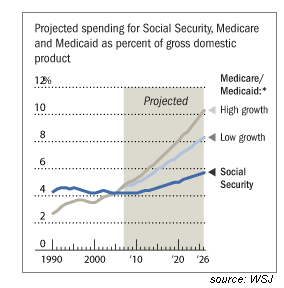 As if paying a fortune to be in poor health isn't bad enough,
the Census Bureau counts 45 million uninsured, and a recent Commonwealth Fund study found
41% of moderate- to middle-income adults did not have health insurance for at least part of
2005, up from 28% in 2001. A Harvard University study found medical bills were a factor in
half of consumer bankruptcies.
As if paying a fortune to be in poor health isn't bad enough,
the Census Bureau counts 45 million uninsured, and a recent Commonwealth Fund study found
41% of moderate- to middle-income adults did not have health insurance for at least part of
2005, up from 28% in 2001. A Harvard University study found medical bills were a factor in
half of consumer bankruptcies.
To sum up: you couldn't design a worse system than ours if you tried. Millions uninsured, hundreds of billions wasted in paperwork, fraud and needless "care," and after spending $2 trillion on healthcare, we're significantly less healthy than our counterparts elsewhere. Where do you even start in designing a solution? I turn to Charles Ruland, an astute reader with a frontline understanding of our current system, for a knowledgeable and very sensible outline of a national healthcare plan which wouldn't bankrupt us and which would undoubtedly provide better, more efficient care to all our citizenry than our current mess of a system. So please read on. (I have added occasional bolding for emphasis) Your question about the "best solution" to our long-term health care cost dilemma...aaah, now you are asking me to tame a monster! But I have a few opinions. Here goes.Does this plan make sense to you? It certainly does to me. Thank you, Charles, for an in-depth and very thoughtful presentation of a workable national healthcare plan which people might actually accept. Once we get the uninsured / minimum coverage problem resolved, we can tackle the equally divisive issue of improving the actual care. For a primer of how poorly we're faring in terms of care, read BusinessWeek's lead article, "Medical Guesswork: From heart surgery to prostate care, the health industry knows little about which common treatments really work." Sobering reading, indeed. May 22, 2006 Housing: 10% Decline May Trigger Financial Ruin Astute reader Bob Decker wrote: Many people don't seem to understand that if you put $100,000 down on a million dollar house . . . and the market drops just 10% . . .you lost your $100,000 of savings/equity and may not ever see it again. 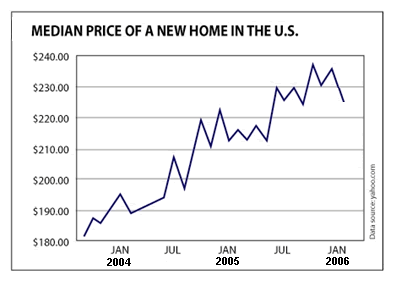 If you need evidence that prices are falling, consider this USA-Today story,
median prices fall, just one of many media stories documenting
the decline in both new and existing home prices.
If you need evidence that prices are falling, consider this USA-Today story,
median prices fall, just one of many media stories documenting
the decline in both new and existing home prices.
Let's take Bob's point and extrapolate it a bit. Consider a family which bought a home for $400,000 at last year's market top, and now for one reason or another find they have to sell: someone lost a job, got transferred, developed a chronic medical condition, etc. In many markets, they will find that the values in their neighborhood and price range have already dropped; in areas such as greater Boston, a 10% decline appears to be common. Let's assume that the family was one of the rare home buyers who took out a conventional mortgage, with 20% down payment in cash and a loan balance of 80%. (As documented here earlier, up to 60% of recent home buyers have selected no down, interest-only loans.) So let's do the math, given a 10% decline in values since they bought: Now, on the sale: 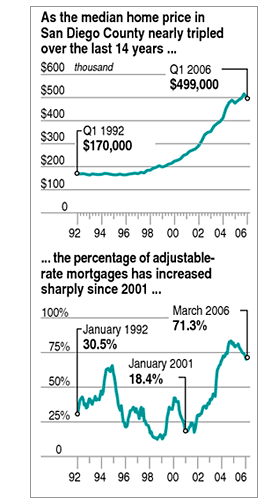
Let's be frank: this poor family which started out with a solid $80,000 and 20% down, has essentially been wiped out by a "mere" 10% decline in housing values, once actual transaction and ownership expenses are accounted for. As for those new homeowners who bought with no money down, this example shows that the transaction fees alone will drive them into bankruptcy, even if they sold the house for their original purchase price. As this chart of the San Diego market illustrates, the number of homeowners exposed to rising mortgage payments is over 2/3 of recent buyers. Combine this with the large number of people who bought homes with no money down, and you get a fuller picture of the damage which will be wrought by a "mere" 10% decline in housing values in an era of rising mortgage rates and "resets" of ARMs to much higher rates. (According to the National Association of Realtors, the median first-time home buyer's deposit last year was just 2% of the price, while 43% of first-timers put down nothing.) Thank you, Bob, for making this all-too-easy to forget point about leverage: works great in a rising market, not so great in a declining market. May 20, 2006 Waimea Canyon Connection? I received a number of good guesses about yesterday's "where is this?" quiz--the Snake River canyon, Zion, Bryce, Copper Canyon in Mexico--and while it certainly bears a strong resemblance to some of those wonderful sights, this canyon is elsewhere in the continental U.S. A more distant park--Waimea Canyon on the island of Kauai, Hawaii--drew one guess and one intriguing mystery. My friend and Ka'a'awa photographer / blogger par excellence Ian Lind sent along this link to a photo of Waimea Canyon taken in 1953 on a family vacation with this comment: "I'm not sure where your mystery park is, but they stole the old railing from Waimea Canyon!" Take a look and decide for yourself--and while you're visiting Ian's site, be sure to explore his other "old kine pics" of Hawaii, his Ka'a'awa sunsets and sunrises, and if you are either a dog or cat person (or both), then his photos of "mornin' dogs" and his own family of felines will make you smile. 
The great thing about this mystery park is the camping--and the pancakes. The two are of course related. There's no place to get "store-bought" pancakes in the park--you make your own over a little Coleman stove. I have to report that, more by luck than skill, I mixed up the the best pancakes of my life at our campsite in this mystery park. (These photos are not from the mystery park; they're of Yosemite Valley, from a 2005 hiking trip with my good buddy Jim Erler.) You know the secret to light pancakes, right? You separate the yolk from the whites of the eggs, and then beat the whites until they form soft peaks. Quickly fold the beaten whites into the batter at the last moment and voila, you get extra-light pancakes which rise ever so fluffily in the pan. 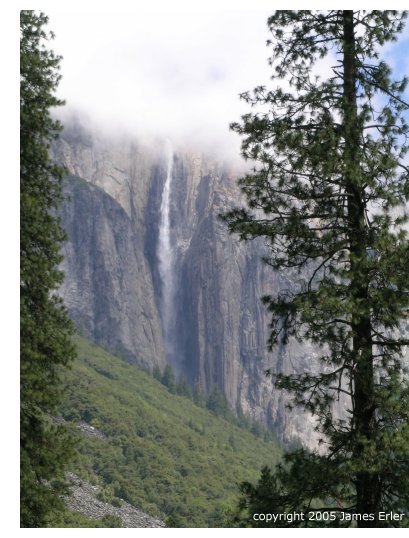 I didn't bother that morning--it was mid-May but still quite cold, and it had taken the sun
warming the tent to rouse me from the sleeping bag. The water jug had a crust of ice on top
but, hey, it's fun to be cold sometimes...get the water hot for coffee and then quickly
assemble the pre-measured ingredients for the pancake mix.
I didn't bother that morning--it was mid-May but still quite cold, and it had taken the sun
warming the tent to rouse me from the sleeping bag. The water jug had a crust of ice on top
but, hey, it's fun to be cold sometimes...get the water hot for coffee and then quickly
assemble the pre-measured ingredients for the pancake mix.
Perhaps it was the altitude, or the crisp morning air, I'm not sure, but those were the lightest, tenderest pancakes ever. Those of you who camp know that everything tastes better when you're camping--partly because it takes a lot of movement to get the camp set up, partly because the outdoors inspires a healthy hunger and partly because it forces you into a very basic form of cooking. Only a few other campers ventured into this park in May, so we had the campground to ourselves. That's ideal, of course, but even camping in busy Yosemite Valley in May has its rewards. While camp cooking tastes wonderful in Yosemite, too--there's a walk-in campground for tent campers on the east side of the valley, and so-called tent-cabins by the river--it's also great fun to put on your clean duds and saunter down to the Ahwahnee Hotel for their Sunday Brunch. The morning walk stimulates your appetite something fierce, and the brunch fortifies you for a good long hike up to Vernal Falls and Nevada Falls. Here's the Official Yosemite National Park website if you want to plan your next visit. If you'd like to solve the mystery park's location, check Chapter Six of my little novel I-State Lines for a big clue. Of course our two heroes are camping; the book is, after all, an exploration not just of the great American landscape but of that great American virtue, self-reliance. May 19, 2006 Where Is This?  Our Friday Quiz features a spectacular but relatively little-known park.
Our Friday Quiz features a spectacular but relatively little-known park.
Hint: this is not the Appalachians or the Sierra Nevada, nor is it the Grand Canyon (the canyon walls there are ocher, orange and rust-red). Be the first to identify the park or landscape behind me, and I'll send you a collector's copy of my book I-State Lines. So email me! Once you read the book, you'll find that a significant section of the two young heroes/anti-heroes' adventures occur in Iowa, the heartland of America. (Yes, each is both hero and anti-hero--it's the American way.) Though the heartland landscape of the country is not as dramatic as that pictured above, its scenery and identity provide many pleasures to observant visitors. The guys (the book's characters, Daz and Alex) set off for Liberty, Iowa, which is an actual town, though the people they meet there are entirely fictional. The name is of course meaningful in multiple ways; it reflects not just the two young protagonists' journey and the core of American identity, but the values rooted in the landscape: the liberties earned by growing one's own food and by actively participating in one's community, and the liberties lost once these values erode. My favorite bookstore to order books from is The Kaleidoscope: Our Focus Is You which happens to be in Iowa. Though physically sited at 112 1st Avenue NW, Hampton, IA 50441 (Tel: 641-456-2787, Fax: 641-456-2809) it is available to you via the miracle of the Internet. Shipping is free on all orders, and you can't beat that. I highly recommend their "for girls only" section. If you're looking for a gift for that bright, sensitive girl in your family or circle of friends, this is a wonderful place to start. May 18, 2006 After the Bubble: How Low Will We Go, Part II 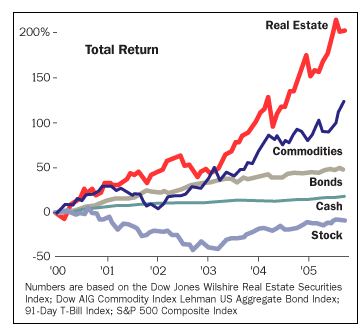 My May 15 entry,
After the Bubble: How Low Will It Go? drew several thoughtful
and well-argued critiques. Interestingly, neither
correspondent disputed the housing bubble--they only contested the severity of the drop.
Fair enough; I think each makes valid refinements to my simple calculations.
But it's also possible that the drop will actually be worse than I projected.
My May 15 entry,
After the Bubble: How Low Will It Go? drew several thoughtful
and well-argued critiques. Interestingly, neither
correspondent disputed the housing bubble--they only contested the severity of the drop.
Fair enough; I think each makes valid refinements to my simple calculations.
But it's also possible that the drop will actually be worse than I projected.
The first analyst, Robert C., notes that my straight line did not accurately reflect the fact that prices fluctuate above and below the trendline--an excellent point: "What I wish you to consider however is the 1% Shiller number and inflation. When you draw a straight line from 1986 you ignore both. Shiller does not and there is another issue. Inflation indicies since 1986 have been adjusted downward 3 times. Taken into account your straight line then curves up at a compound 1% on top of inflation at the old measure not the new one. OKAY, big deal. We are still on the same page but I see prices only 1.8x trendline while you are showing 2.3x overvaluations. Of course if you look again at your graph and adjust for my "corrections" you see c1970 and c1995 as periods of some undervaluation which in the fullness of time seems reasonable does it not? We come back together at the end because ultimately we need to dip below trend to return to trend. So, your return to norm is my bottom of the market." (emphasis added)Next up is a well-argued refinement of my calculations: "1. 20 years of 1% increment is not 20%. Its 1.01 times 1.01 20 times and minus 1. Thats roughly 22%. 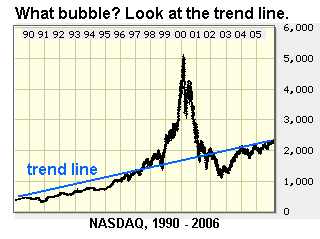 Let's look at these assumptions more closely. While it's true that the last housing cycle
took six years to decline, it was not a bubble. Bubbles tend to fall as quickly as they rise.
The chart to the right illustrates the dot-com era Nasdaq. While this is a stock market,
the first chart reveals that the current real estate bubble inflated rapidly from 2003 through
mid-2005--a mere 2.5 years.
Let's look at these assumptions more closely. While it's true that the last housing cycle
took six years to decline, it was not a bubble. Bubbles tend to fall as quickly as they rise.
The chart to the right illustrates the dot-com era Nasdaq. While this is a stock market,
the first chart reveals that the current real estate bubble inflated rapidly from 2003 through
mid-2005--a mere 2.5 years.
Given the unprecedented level of excess in today's housing bubble, it is likely that the bubble will deflate as quickly as it rose. This would mean the majority of today's gains might evaporate in a little as 2 years. And as my first correspondent noted, markets fluctuate below the trendline after an extended period above the trendline--a behavior clearly visible in the chart of the Nasdaq bubble. In other words, the housing market is likely to fall well below the trendline in the initial post-bubble decline. Thus, while my second correspondent argues quite effectively for a "reversion to the trendline" number of $355,000, rather than my figure of $315,000, history suggests trendlines are broken to the downside as the bubble pops. This is a strong argument in favor of my original projection that housing prices will have to fall over 50% before reaching bottom. If prices fall fast, the effects of inflation will have little effect. If the median price of a S.F. Bay Area home falls from $715,000 to "only" $355,000 rather than to $315,000, will anyone's financial ruination be prevented? No. Next up: inflation. My second correspondent suggests that if the dollar falls in value, this will trigger inflation which will act to inflate property values. This sounds very reasonable, and here's why: But wait. If mortgage rates rise to 13%, who can afford to pay $700,000 for a house? That's the gotcha. No one can. That's the flaw in the idea that higher inflation will support housing prices. To keep inflation from accelerating out of control, Paul Volker and President Reagan raised interest rates to 15%, effectively ending all lending for autos and houses. The automakers, unable to sell cars with cheap loans, laid off hundreds of thousands of workers and lost billions. Home building dried up and blew away, as did real estate sales--who could qualify for a mortgage at 15%?--and of course, housing values sank, too. It was called "stagflation": stagnant economy, wages and employment coupled with high inflation. The "medicine" is high interest rates, which causes housing to drop back to what is affordable. Care to know what a $600,000 mortgage costs at 13% interest? Try $6,637 per month on a 30-year fixed mortgage. How many people can afford that? As I have noted here before: housing prices are correlated to the interest rate--period. If interest rates double from 5% to 10%, then housing will drop by 50% because people can only afford to pay so much for housing. You can finesse all kinds of numbers, but it all comes back to affordability. Once interest rates rise, housing necessarily plummets beause there are simply no buyers who can afford the inflated prices. I don't want to get too technical here, but there's also a fatal flaw in the idea that the dollar will drop through the floor. If euro banks are paying 4.5% and U.S. Treasuries are paying 9%, which one are you going to buy? The Treasuries, of course--and in so doing, you'll be buying dollars--which guess what, puts upward pressure on the value of the dollar. So as interest rates rise in the U.S. due to inflation, the dollar may well rise rather than fall. So we may well get deflating housing and appreciating currency at the same time. 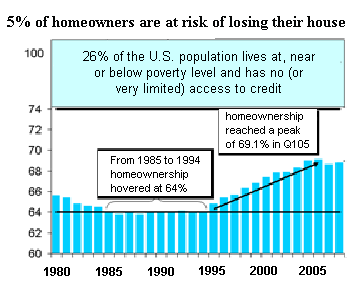 Three other realities will send house prices plummeting to below-trendline levels: the
complete lack of buyers, oversupply of housing due to foreclosures and the loss of jobs.
As this chart reveals, virtually everyone who isn't poverty-stricken or in prison already
owns a house. As foreclosures rise (see
patrick.net for the latest news on foreclosure rates rising dramatically) then the current
oversupply of homes will climb to unprecedented heights--an ascent which will be accelerated by
massive job losses in the housing sector, which as CNN reports below, is fully 20%-25% of the
entire $12 trillion U.S. economy.
Housing slowdown to be widely felt:
Three other realities will send house prices plummeting to below-trendline levels: the
complete lack of buyers, oversupply of housing due to foreclosures and the loss of jobs.
As this chart reveals, virtually everyone who isn't poverty-stricken or in prison already
owns a house. As foreclosures rise (see
patrick.net for the latest news on foreclosure rates rising dramatically) then the current
oversupply of homes will climb to unprecedented heights--an ascent which will be accelerated by
massive job losses in the housing sector, which as CNN reports below, is fully 20%-25% of the
entire $12 trillion U.S. economy.
Housing slowdown to be widely felt:
"Housing accounts for between a fourth and a fifth of the GDP (gross domestic product)," said Walter Molony, spokesman for the National Association of Realtors, referring to the broad measure of the nation's economic activity. "So many other industries see sales tied to the purchase of a home. We get calls from Singer sewing machines about our home sales statistics."If the industry itself is predicting a direct job loss of 375,000--never mind the furniture salepeople, countertop manufacturers, and all the other millions of people indirectly employed by the housing industry--then you can bet the reality will be much worse. So take your pick: a decline in median house prices from $715,000 down to "only" $350,000 or a slightly more severe drop to $315,000. Will it really make any difference? Sadly, probably not. May 17, 2006 Why Post-Bubble Rents Matter 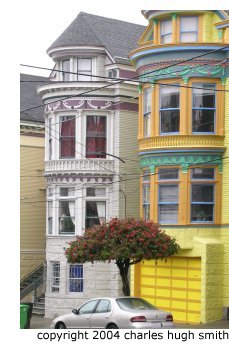 Why are post-bubble rents important? For one thing, they will, with enormous consequences,
set the official rate of inflation and thus future interest rates. As described here in
The
Housing - Inflation Connection, the cost of renting housing is fully 40% of the Consumer
Price Index (CPI). As rents dropped during the housing boom, they artificially suppressed
the CPI. If rents ever rise, they will quickly boost the CPI.
Why are post-bubble rents important? For one thing, they will, with enormous consequences,
set the official rate of inflation and thus future interest rates. As described here in
The
Housing - Inflation Connection, the cost of renting housing is fully 40% of the Consumer
Price Index (CPI). As rents dropped during the housing boom, they artificially suppressed
the CPI. If rents ever rise, they will quickly boost the CPI.
The big question is: will rents fall or rise as the housing bubble deflates? Given that part of what is causing the bubble to pop is overbuilding--the number of new condos and houses has outstripped demand--then common sense suggest rents will drop as desperate owners will lower rents to fill those hundreds of unsold units with tenants. That sounds reasonable--but then why does the Federal Reserve's Susan Bies think rents will actually rise? Rising rents may push CPI higher, Fed's Bies says. Noting that the CPI's gauge of housing costs is based on rents, Bies told a banking conference in answer to a question: "We've come through a period of weaker rents. Now, housing has really sort of peaked ... that may rejuvenate rents and so you may see may see that, in turn, higher (CPI) inflation going forward."You've probably read about "chain deflators" and all the arcane mechanisms by which the "official" rate of inflation is calculated, but any consumer can tell you inflation has been rising at a far faster clip than the official rate--however it's massaged. The "true" CPI has been artifically suppressed for the past 4 years because the housing boom dramatically lowered rents. In that sense, the Fed will be hoist on its own petard if the long-suppressed CPI breaks above the "true" rate. Why does this matter? Because bond traders expect the yield on a bond to exceed the rate of inflation. If inflation is tripping along at 5% annually, who would be dumb enough to buy a bond--which could drop precipitously in value should the dollar decline--which pays only 5%? You're nor making a dime on your investment, even as you're taking on a major risk of the dollar losing value. While the Fed governors have the luxury of playing around with chain deflators and the like, the bond market is the body which actually sets the long-term (mortgage) interest rates. If buyers of U.S. Treasury bonds start to get nervous about a rising CPI as evidence of rising inflation, they might demand a larger premium of risk--in other words, "show me the money or I'm not buying your bond." If bond rates rise to 8%, mortgage rates won't be far behind-- they will probably be ahead. And what do rising mortgage rates mean for the housing market? Declining prices, higher Adjustable Rate Mortgage (ARM) resets and thus more foreclosures as cash-strapped homeowners go broke. Ouch. But then maybe rents will fall as all these hundreds of thousands of units come on the market. Not so fast. There are countervailing forces which could, as Ms. Bies suggests, actually cause rents to rise. How is this possible? There are a number of factors: Boarded up or unfinished highrises were a common sight in Asian cities such as Bangkok after the Asian Contagion financial crises of the late 90s. If the builder or developer goes bankrupt, the lender is also not going to enter the rental housing business. The lender itself may well be pushed into bankruptcy should multiple developers and builders go bust. That would be the normal course of events in an over-building bubble such as this one. Which scenario is correct? Perhaps both. My photo of the two stately Victorian homes in the Haight-Ashbury district of San Francisco provides a visual metaphor of how the rental market may develop. Rental units in desirable locations with good schools and close proximity to jobs and shopping districts will likely be rewarded with substantial increases in rent, even as thousands of houses and condos languish empty in overbuilt, distant or otherwise unattractive locations. The bland Victorian represents these perfectly good but utterly undesirable homes which may not attract renters at a price which enables the owner to cover his/her costs. Thus it may well turn out to be a bifurcated market in which a million foreclosed units sit vacant even as rents are rising in desirable locales which were not overbuilt. This would truly be the worst of all possible worlds, as rising rents would jack up the CPI even as lenders foreclosed on thousands of homes and then went bankrupt themselves as mortgage rates rose in lockstep with the CPI. Implausible? People who have witnessed the aftermath of overbuilding coupled with rising mortgage rates won't think so--they've seen rows of empty forlorn buildings and houses before. May 16, 2006 After the Bubble: Rents and Housing Values 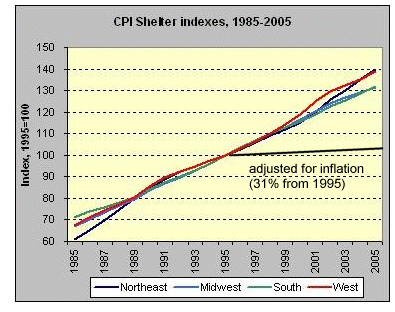 Why do bubbles burst? One reason is that the supremely unprofitable nature of the
bubble asset becomes abundantly obvious. For instance, housing. Back in the overheated
real estate market of 1980-81, (Yes, Virginia, we had bubbles in the past, too) I recall an older real estate attorney shaking his head in dismay
as he told me, "It makes no sense to buy a house as an investment now, but people keep
buying them anyway." His point was that people were buying into a substantial monthly loss
which they presumed/hoped would be more than offset by appreciation.
Why do bubbles burst? One reason is that the supremely unprofitable nature of the
bubble asset becomes abundantly obvious. For instance, housing. Back in the overheated
real estate market of 1980-81, (Yes, Virginia, we had bubbles in the past, too) I recall an older real estate attorney shaking his head in dismay
as he told me, "It makes no sense to buy a house as an investment now, but people keep
buying them anyway." His point was that people were buying into a substantial monthly loss
which they presumed/hoped would be more than offset by appreciation.
My friend's point was simple: if an investment doesn't make money in the here and now, it's a lousy investment. As buying a second, third, fourth or fifth house or condo has become a popular investment alternative to a boring, low-yield bond or underperforming mutual fund, my friend's observation becomes highly relevant. It makes no business sense to count on appreciation if you're digging yourself a deeper financial hole every month. This is, of course, how bubbles form. With interest rates low, safe investments like certificates of deposit and bonds are unattractive; they're barely treading water above the rate of inflation or even losing ground. So the speculative, risky investments attract investors. As the money pours in (to gold, old cars, Chinese Internet stocks, copper futures, real estate, etc. etc.) then the asset prices rapidly inflate, attracting even more money to a "sure thing," "wave of the future," "real value," etc. etc. At some point, the punchbowl of cheap and easy credit is withdrawn, and the bubbly-drunk guests are stunned to find their high-flying jewel-encrusted carriage reduced to a mere pumpkin. 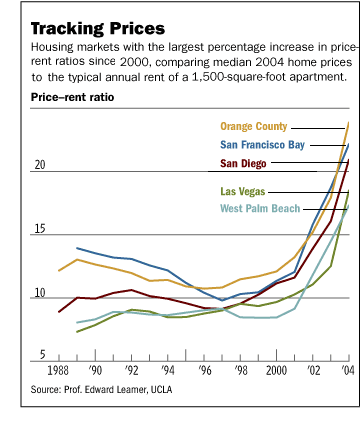 Can't sell that condo or house? "Just rent it out." Fine; but how does rental housing
stack up as a business in the real world? Let's take a look. First, a caveat. Any
scenario or extrapolation can be nitpicked or challenged in dozens of ways; quibbles abound
when someone has a vested interest in discrediting a line of reasoning or evidence.
Can't sell that condo or house? "Just rent it out." Fine; but how does rental housing
stack up as a business in the real world? Let's take a look. First, a caveat. Any
scenario or extrapolation can be nitpicked or challenged in dozens of ways; quibbles abound
when someone has a vested interest in discrediting a line of reasoning or evidence.
So don't take my word for it. If you're thinking of renting out your vacation or investment property, go talk to some landlords with five or ten years of experience. As this chart shows, the historic ratio between housing and rents--that is, the snapshot of housing as an actual business rather than a speculative gamble--has reached hitherto unknown heights. "Just rent it out." Easier said than done. For starters: no uninsured worker ever fell off the roof of a municipal bond. No CD was ever trashed by vengeful tenants, and the plumbing bill for a savings account never rocked you back on your heels. Then there's the uncomfortable fact that rents have declined in many locales since the 2000 heyday, or have been flat for years: Bay Area rents stay the same. As the first chart shows, rents nationally have barely kept ahead of inflation. In other words: even as housing has shot up, rents have remained flat or even declined. Anyone expecting to make money on rising rents may be sorely disappointed. According to Barron's, Rental income nationally has fallen to $147.8 billion from the peak of $186.6 billion back in April 2002. OK, let's crunch some numbers. Let's take a property purchased for $500,000 that rents for $2,000 a month. Is this a good business? Maybe a $500,000 house rents for more than $2,000 in your city, but in my region, since $500,000 only gets you a rundown bungalow in a lousy neighborhood or a small condo, you'd be lucky to get even close to $2,000 rent for your $500K investment. First off, unless you "fudged" (i.e. lied) on your loan application, claiming that the property was your principal residence, an investment property carries higher loan rates and requires a 20-25% down payment. So let's assume you put down $100,000 and incurred another $5,000 in loan and closing costs, meaning that your investment in the property has to yield at least what the $105,000 cash would earn in a muni or high-grade corporate bond--at least 6% (but 7% is certainly available) or $6,300 a year. Next is your loan balance of $400,000. Let's say you have an interest rate of $6.5%--very good for an investment property.The payments of principal and interest, according to the calculator at MSN Money, would total $2,528 per month. For maintenance, let's assume your condo fees are about $400, or general upkeep on the house (maintaining the yard and typical repairs) will run an equivalent amount. (Remember that every once in a while there will be large bills for items such as replacing old sewer lines, a new furnace, a new roof, tree trimming, a new countertop or bathroom floor, etc., unless it's a brand-new house.) Then there's management fees, which run about 6% of rent (even if you handle this yourself, your time isn't free), so that's 6% of $24,000 annual rent or $1,400 ($120 a month). Insurance varies widely around the country but let's plug in $100 a month ($1,200 annually). Property taxes also vary widely, but let's assume 1% annually is fair (though it's much higher in many locales such as New York, Texas and California). That's $5,000 a year or about $400 a month. Since it's unwise to assume the property will never be vacant, let's shave 10% off the annual rent as an allowance for vacancies, reducing the $2,000 per month to $1,800. (Note that realtors are pleased to wave huge summer rental numbers around during the sales pitch but the reality is that many vacation homes sit empty unless someone spends major money advertising and promoting the property.) As expenses add up to about $3,500 per month, that leaves a net loss of $1,700 per month, or $20,400 annually. But wait, you say--what about depreciation? Fine. The first thing to note about depreciation is that it comes back to haunt you when you sell the property, as all your depreciation is "recovered" when it comes time to pay the tax on your gain (if any). And remember, as an investment, there's no $500,000 giveaway on the gain; you pay tax on dollar one of that gain and recovered depreciation. Also note that you can only depreciate the building, not the land, so you can't depreciate the full $500K value. Taking a standard 40-year depreciation (let's say the building is $350,000 of the $500K price, yielding an annual depreciation of $8,750), your loss is knocked down all the way to $11,650: about a $1,000 out of pocket a month, even counting depreciation. And let's not forget that you're foregoing $6,300 in net income by leaving the $105,000 cash in a losing investment. You can quibble--but I got a loan at 5%, rents are going up in my area, I'll maintain the place myself, etc. etc.--but the bottom line is unavoidable: this is a lousy business proposition unless you can collect at least $3,500 rent per month for the property. Then there's the risks I mentioned. If you try to save money by hiring unlicensed, uninsured workers, and one gets injured, you could be facing a lawsuit which your homeowner's insurance may be unwilling to settle. There are no guarantees in the rental housing business. You may not be able to find a decent tenant no matter how much you advertise, or you may get a tenant who suffers some family trouble or medical emergency and as a result can't pay the rent. The rental housing business is not risk-free. Neither are bonds, of course, but a short-term CD isn't going to get a stopped up toilet or suddenly stop paying the rent. "Just rent it out." Sure, but be aware it isn't that easy and it almost certainly isn't profitable--unless you bought ten years ago in a desirable neighborhood and have spent serious money keeping the property in tip-top shape. May 15, 2006 After the Bubble: How Low Will It Go? 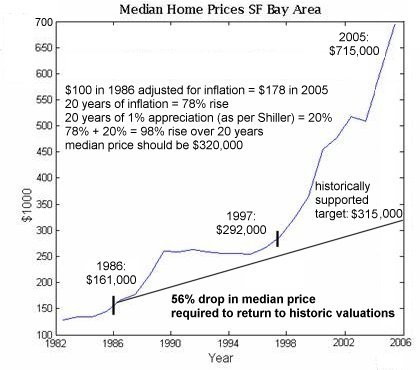 How low will housing go as the bubble bursts? For an answer, let's turn to
Irrational Exuberance
How low will housing go as the bubble bursts? For an answer, let's turn to
Irrational Exuberance
Shiller's book, which presciently predicted the collapse of the Nasdaq stock market in 2000 just weeks before that mighty bubble broke, has been re-issued with an analysis of the housing bubble. Shiller's key takeaway is that historically, housing in the U.S. rises, at best, at 1% per year not including the effects of inflation, that is, "real" appreciation. This chart depicts what history suggests will happen to housing prices: to return to this historically supported level, housing in the San Francisco Bay Area must drop 56%. Impossible! you gasp in dismay. They're not making any more land, the population is growing, etc. etc. etc., all the "common sense" reasons given for why housing is in a permanent uptrend. Funny, but that sounds just like the truisms given when tech stocks like PALM and SUNW were over $100, just before they began their long, slow agonizing decline to $5. The Internet did "change everything" and it continues to grow rapidly, but those realities did not translate into overpriced $100 per share stocks rising to $200, as widely predicted at the time. Why? There are two fundamental reasons why any bubble bursts: a statistical phenomenon called "reversion to the mean" and the deeply unprofitable nature of the bubble as a business is eventually revealed. Although reversion to the mean has technical definitions, for our purposes we can understand it as the law of averages; that is, a series of data will eventually revert back to the average. The farther it rises from the average, the higher the probability it will revert or return to historic averages. If the elk population explodes one season, for instance, then disease, overgrazing and a subsequent rise in predators all act to bring the elk population back down to historic norms. In the world of investing, the growth stocks of the 60s, labeled the "nifty 50," rose to great heights before falling back to earth once their price-earnings ratios rose to nose-bleed levels. In other words, the amount of money they were making simply didn't support the price of their stocks. For an explanation of reversion to the mean which relates to investment, visit the coffeehouse investor. Reversion to the mean is a statistical phenomenon, not an explanation. The underlying mechanisms for a reversion to the mean have been explored here in previous posts, and in many other sites: a veritable flood of cheap and easy money inflates the bubble, which inevitably deflates when loose lending standards are tightened and interest rates rise. Nothing fancy here; it's also called "the business cycle." Natural growth rises to excess when excessive liquidity gooses it, and then collapses when that liquidity is withdrawn or begins to cost real money. To borrow from Tolstoy: every healthy market is the same, but every bubble bursting is unique in its misery. There are plenty of absolutely bubblicious markets in the U.S. (and indeed, the world--check out Shanghai is you want a real fright), but I chose the one close to home: the San Francisco Bay Area. Shiller's analysis works on any bubble, anywhere, but obviously, the less dramatic the rise, then the less dramatic the decline. This chart provides a very clear picture of what a bubble looks like: a slow rise in values which suddenly turns up in a hockey-stick ascent to unsustainability. Note that the decade between 1986 and 1997 ended with housing values a bit above the historic line, but not by much. During all those years of flat-to-modest appreciation, the population was also growing, they weren't making any new land, etc. etc.--all the conditions were present which are trotted out to justify the bubble. Note that the hockey-stick rise began as the Nasdaq bubble created hundreds of billions in new wealth in the late 90s. Let's go over the numbers. According to the Bureau of Labor Statistics, $100 in 1986 equals $178 in today's (devalued) money. To that 78% rise due to inflation we add Shiller's 1% per year appreciation in "real" terms, which adds up to a historically supported value 98% above the 1986 median price of $161,000. In other words, a reversion to the historic mean will bring Bay Area median prices down from $715,000 to around $315,000--a decline of $400,000. This is the inescapable conclusion of Shiller's analysis and historical trends dating back to the 19th century. It cannot be denied; but you can of course retreat into denial. Sadly, that's what most investors did back in the dot-com heyday. As stocks tumbled, every brief uptick was embraced as the "bounce back" to the good old days, and every such bounce was a sucker's rally, leading only to further precipitous declines. For the median prices in Boston, Austin, Raleigh and the Bay Area, go to median housing price data from 1986 to to 2005 courtesy of the University of Texas. And a tip o' the hat to my colleague Marinite, proprietor of the excellent Marin Real Estate Bubble, for reprinting the chart on his blog. May 13, 2006 Financial Chickens Coming Home to Roost Allow me to quote my entry from May 6: "The Fed meets on May 10. Mark your calendar: May 11 the decline starts and then rapidly picks up velocity. The "smart money" has been exiting all month while the con was set. Reality has a nasty habit of trumping wishful thinking." 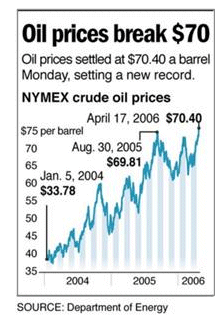 With the stock markets in a free-fall, it would seem the call was correct. While I would like
to claim the mantle of financial genius, it was actually easy; so many chickens are
coming home to roost, the henhouse was bound to collapse. Here are just a few of the
issues with lit fuses:
With the stock markets in a free-fall, it would seem the call was correct. While I would like
to claim the mantle of financial genius, it was actually easy; so many chickens are
coming home to roost, the henhouse was bound to collapse. Here are just a few of the
issues with lit fuses:
Let's start with an expose of a very risky practice: borrowing money against one's stock and bond portfolio, a.k.a. margin debt, to spend on consumerist frivolities. As reported by the Wall Street Journal: Margin Loans Make a Comeback: Wall Street Pushes Investors to Borrow Against Portfolios to Buy Cars, Homes UBS AG's wealth-management division says about 75% of its more than $10 billion in securities-based loans are used for purposes other than buying additional securities, including for purchasing real estate and cars or for paying tax bills and a child's tuition.With the prime rate at 8%, that margin debt isn't so cheap anymore. And as stocks plummet, some of those unwise investors will get margin calls, requiring them to sell stocks to bring their cash back up to at least 50% of their account value. Then that selling drops the market more, triggering more margin calls...I think you see the direction this takes: down. Here's a snapshot of stock speculation running wild from Yahoo Finance on Friday, May 12: "Schwab reports April activity that includes: Net new assets brought to the company by new and current clients in April 2006 totaled $4.6 bln. Total client assets were a record $1.300 trillion as of month-end April, up 22% from April 2005 and up 1% from March 2006. Client daily average trades, which include Schwab Investor Services asset-based trades and Schwab Institutional asset-based trades, were 293.3 thousand in April 2006, up 44% from April 2005 and up 5% from March 2006."What do you reckon is driving a 44% increase in trading? Could it be speculation? The short answer is: what else drives trading up 44% in one year? Is it the smart money dumping and the soon-to-be-impoverished investors buying wildly? And where did that 22% increase in assets come from? Borrowed off some real estate, perhaps? Here's an editorial from the Wall Street Journal, decrying the lack of a sensible energy policy in the nation: When the House had a chance to take a positive step to increase gasoline supplies and lower prices last week by making it easier for oil companies to expand their domestic refinery capacity -- Northeastern Republicans teamed with Democrats to bring the measure down. The U.S. now consumes 21 million barrels of oil a day but has a refining capacity of only 17 million. As usual, the loudest Congressional complainers about high gas prices voted as a bloc to keep supplies precariously low.The key takeaway here is that the U.S. isn't just dependent on foreign suppliers of raw oil--we are also dependent on foreign refiners. If you think gasoline is expensive now, what do you reckon would happen if anything happened to disrupt that 4 million barrels a day of refined petroleum products being shipped to the U.S.? 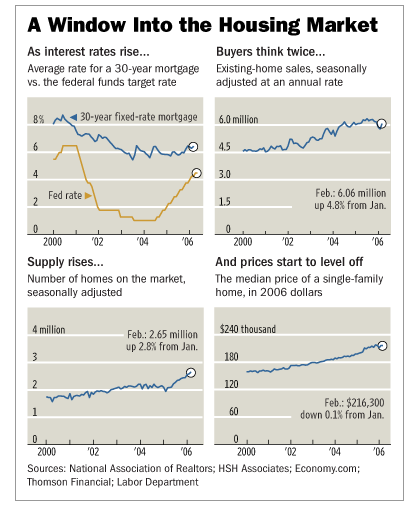 For a quick look at housing, let's turn to the S.F. Chronicle:
Cooling market squeezing Bay Area developers:
For a quick look at housing, let's turn to the S.F. Chronicle:
Cooling market squeezing Bay Area developers:
At GreenCity Lofts, a 62-unit development in Emeryville that touts sustainably-harvest wood floors and edible landscaping, 1,100-square-foot lofts that recently sold for about $650,000 are now being offered at $499,000.That's a 23% drop in a matter of months. How do the buyers who paid $150,000 more for a smallish loft feel now? Just like everyone else who overpaid last year--lousy, angry, scared, and maybe in a mood to sue the developers. Here's another staggering real estate tidbit from the Wall Street Journal on negative equity: A full 29% of people who took out mortgages or refinanced in 2005 have no equity or negative equity in their homes, according to Christopher Cagan of First American Real Estate Solutions, a data provider. That's a shocking figure, compared with 10.6% of people who took out mortgages in 2004.And a final wrap-up of the housing bust from the Wall Street Journal: Night of the Living Debt: The biggest and most underrated development in the U.S. economy over the past year is that the personal-savings rate went negative. In other words, Americans spent more money than they made last year -- for the first time since, oh, the Great Depression. The average worker hasn't participated in the economic recovery. Inflation-adjusted hourly and weekly wages are still below where they were at the start of the recovery in November 2001, points out the Economic Policy Institute.So let's see: we have no coherent energy policy, margin debt is being used to finance consumer baubles and second homes, a third of recent home buyers have either no equity or negative equity-- and what exactly is going to persuade them to make payments when money gets tight?-- wages are flat, but really, folks, everything's great. Please repeat this mantra until your critical facilities cease functioning: energy costs don't matter anymore, real estate is simply "returning to normal," unemployment is low, the GDP is growing healthily and everything is peachy. If you're having trouble swallowing that mantra, try doubling your daily dosage of Zombiestra (TM). May 12, 2006 Identity and Landscape  These comments from Chinese film director Chen Kaige (of "Farewell My
Concubine" fame) address a topic which is both profound and rarely noted: the rooting of
personal identity in the landscape, architecture and neighborhoods of a nation.
These comments from Chinese film director Chen Kaige (of "Farewell My
Concubine" fame) address a topic which is both profound and rarely noted: the rooting of
personal identity in the landscape, architecture and neighborhoods of a nation.
Chen, 53, can barely recognize his hometown of Beijing. He grew up in a traditional household during the Cultural Revolution. What he sees now is a polluted, crowded city that has gradually replaced its older architecture with cold, modern designs.  This instantly resonated
with me, for it expressed a key theme of my novel I-State Lines: the grounding of
one's personal and cultural identity in the moral and physical landscape of one's country. This instantly resonated
with me, for it expressed a key theme of my novel I-State Lines: the grounding of
one's personal and cultural identity in the moral and physical landscape of one's country.
The two young characters in my book feel no affinity whatsoever for the landscape of malls and advertising which pervade America, nor do they feel anything but loathing for the consumerist ethic which has taken over the American soul. They are drawn to farmland, open spaces, and cities with real neighborhoods, not sterile McMansionlands. They are seeking their own identities by working their way across the U.S. in search of authentic landscapes and work--productive work, not shuffling papers or feeding the greed implicit in a consumer-driven economy. Be the first to identify the stretch of river behind me and Ashton Erler, and I'll send you a copy of my book. So email me! (Hint: it's east of the Rockies--way east.) May 11, 2006 The Housing-Savings-Recession Connection 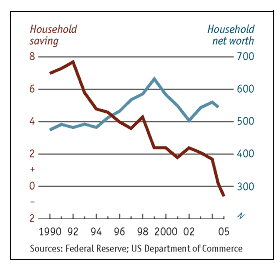 You may have noticed that I always source data from either official government
sites or mainstream media sources. Why? To avoid sounding like just another panicky
doom-and-gloomer. In other words, if The Economist, Wall Street Journal, Barron's, BusinessWeek
and Foreign Affairs are reporting the same points, then it's much more difficult
to dismiss it all as so much balderdash. It depends, of course, on one's definition of
doom-and-gloom; for some, it's planetary disaster, while for others it's a deep economic
recession. I consider the latter not so much doom-and-gloom as simply part of
the typical business cycle. It is a healthy and indeed, necessary tonic to over-borrowing
and over-spending.
You may have noticed that I always source data from either official government
sites or mainstream media sources. Why? To avoid sounding like just another panicky
doom-and-gloomer. In other words, if The Economist, Wall Street Journal, Barron's, BusinessWeek
and Foreign Affairs are reporting the same points, then it's much more difficult
to dismiss it all as so much balderdash. It depends, of course, on one's definition of
doom-and-gloom; for some, it's planetary disaster, while for others it's a deep economic
recession. I consider the latter not so much doom-and-gloom as simply part of
the typical business cycle. It is a healthy and indeed, necessary tonic to over-borrowing
and over-spending.
I used to be rather sanguine about the future until I began looking at the data--nasty habit, that, looking for clues to the future in data and charts. It really plays havoc on your most cherished illusions, prejudices and ideological truisms. With that flourish of trumpets, let's start with economist Martin Feldstein's article in the current issue of Foreign Affairs, The Return of U.S. Savings. 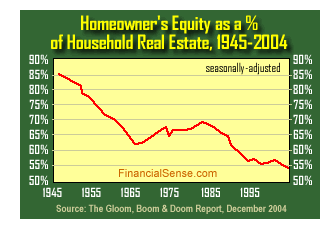
The U.S. savings rate has been falling for decades. But that downward trend will likely soon be reversed, as factors such as rising mortgage interest rates force Americans to start saving more. The change will ultimately be for the better, but in the short term it could cause serious problems for the United States and its trading partners unless they start preparing immediately.Let's see if these charts align with Feldstein's assessment. The first chart shows both the steady decline in savings into negative-number territory--that is, Americans are spending more than they earn, including wages, dividends and interest--and the recovery in household wealth from the 2000 dot-com debacle. That increase in household wealth enabled the borrowing spree which has driven consumer spending up even as savings sank to negative numbers. Though real estate has risen at astonishing rates since 2000, the second chart reveals that home equity has actually been declining. How is this possible? Easy--the magic combination of rising home equity and loose money which stimulated huge consumer borrowing. Here is clear evidence of that massive borrowing. Even as interest rates dropped to multi-decade lows, the percentage of peoples' incomes devoted to debt service has risen to new heights, as shown in chart 3. 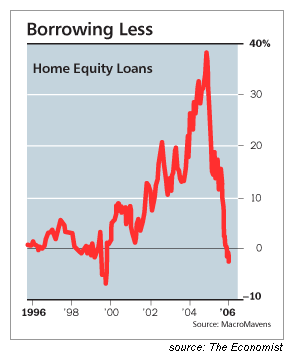
How can we be sure that it's rising real estate values which are underpinning all this borrowing? Look at chart 4. Even as GDP has risen steadily and the stock and bond markets have soared from their 2002 lows, housing has risen to an uprecedented percentage of GDP, far exceeding the value reached at the last boom-bust cycle top in 1990. Chart 5 shows that the immense extraction of home equity which has been sustaining consumer spending has come to an abrupt end. As house prices stabilize, borrowing costs / mortgage rates rise and household debt payments reach historically unsustainable levels, borrowing ceases. This is the point at which Feldstein predicts American households will start saving by restraining their spending. As a corollary to that reduction in consumer spending and a rise in savings, we might also posit that households will also begin paying down debt--a trend which we can see in chart 3 as the economy slowed in the early 90s. For more on these trends, check out these articles from BusinessWeek: why more households are feeling flush Home is where the worth is What's the net result of such a massive reallocation of income to savings and repayment of debt, away from consumption? It's called a balance-sheet recession: Although repairing balance sheets is the right and responsible thing to do, when many simultaneously shift their priorities from spending maximization to debt minimization, Adam Smith's Invisible Hand reverses its normal direction and shrinks both the economy and the money supply. (edited excerpt)For more on the phenomena, check out Japan's balance sheet recession (BusinessWeek) So here's the Housing-Savings-Recession Connection. As borrowing costs dropped and housing values rose, it made little sense to save money and all the sense in the world to borrow huge sums of "free lunch" money from all that home equity wealth and spend it freely. Now that interest rates are rising and housing prices are leveling or dropping, people have stopped borrowing. If Feldstein (and history) is right, households will start saving again, and using some of those savings to pay down debt. This will trigger a balance-sheet recession, in which consumers "repair" their balance sheet by spending less and paying down consumer debt. Is there any other possible interpretation of these charts? May 10, 2006 The New Disease We Just Know You've Got 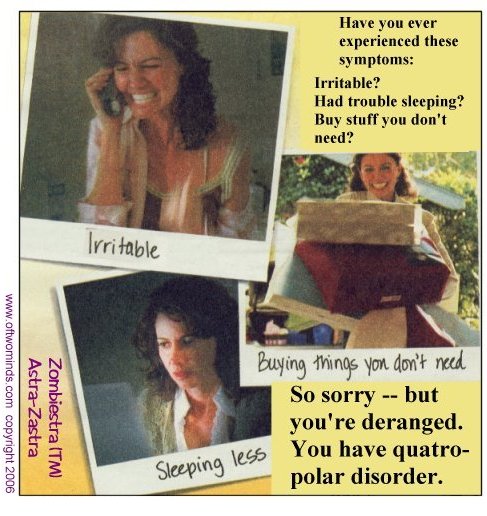
* * * * * * * * * * * * * * * * * * * * * * * * * * * * * * * No doubt you've heard of bi-polar disease, depression, anxiety disorder and restless leg syndrome. Maybe you've dodged all those bullets, but before you sigh in relief, answer this simple quiz: Sorry, but you suffer from quatro-polar disorder. Yes, you. You're a classic case, and don't try to deny it. The first step to getting well is to admit it: your mood swings not just up and down, but sideways, and in both directions. (Unless you're a right-wing nut or left-wing fanatic, in which case you swing only up and down and left or right, which makes you a hardcore sufferer of the dreaded, incurable tri-polar disorder.) Fortunately, there's a cure--one which your overworked doctor can easily be convinced to prescribe, should you rush in and demand Zombiestra (TM). But only do so if you have full drug coverage in your medical plan, or if you're filthy rich. Only then will you be able to afford the wondrous relief to everyday life which is Zombiestra (TM). You may have mis-diagnosed yourself, thinking that buying all sorts of worthless junk just made you a normal, healthy American consumer. Wrong! That's a sure sign of quatro-polar disorder. Ditto for being irritable or having trouble sleeping enough. Just because you have a two-hour commute and have to get up at 4 a.m. to beat the traffic, or that thanks to layoffs and rising workloads, you're working 10 hours a day just to keep your job--that's no excuse! You're suffering from quatro-polar syndrome, to be sure. Fortunately, there's Zombiestra (TM). (First check with your insurance plan to make sure they cover diseases which are newly "discovered," then hound your overworked doctor for the prescription. Be proactive. Don't take no! It's your right to be over-medicated with drugs which only work 20% of the time.) Studies show that about 3% of the population suffers from mental disorders that can be greatly alleviated by psychotropic medications. Unfortunately, this leaves 97% of the population beyond our reach. Here at Astra-Zastra, we started with the intention of doing good but decided instead to do well--very well. Making piles of money just didn't satisfy our greedy stockholders, so we set out to make veritable mountains of profit. And that means enlarging our customer base to you. Yes, you. Unless you don't have any medical insurance. Then to heck with you, buddy, suck it up. Work it off. Go talk to your pastor. Whatever. Just don't ask us for a handout. We've got places to go, things to do, congresspeople to see, so shove off. Get lost, scram. Anyway, back to our problem. We need something to sell to you, a basically average human being. Our marketing people hit on a brilliant scheme: convince you, a gullible, know-nothing-about-science, easily swayed by fad, unhealthy, lazy, just-want-a-pill-quick-fix American, that you had a previously unknown condition that would magically be cured by our absurdly overpriced drug--oops, we mean medication. (That sounds so much more soothing than "drug," doesn't it?) They key, we discovered, is to identify symptoms which everyone has from time to time--irritability, sleeplessness, restlessness, a desire to shop, etc.--and turn them into symptoms of a horrible disease which needs correcting. Everyday life--getting irritated, for instance--is no longer the normal human condition; it's a disorder. In other words, were you a zombie, an organism without emotions or stress reactions of any kind, you wouldn't need Zombiestra. But alas, you are human, and therefore you have emotions. Too bad, because that means you're ill. And you very desperately need Zombiestra (TM). Of course nothing's perfect, so even Zombiestra only works for about 20% of the populace--the same percentage that reported feeling better after they took a sugar-pill placebo. And it does tend to cause bed-wetting, heart palpitations and extreme road rage, but we've got medications to counter those side-effects as well. So for maybe $500-$600 a month in meds, you're out the door and feeling nothing. Or. worst case scenario, all the symptoms which were supposed to be alleviated are still present--you're still racking up charges on your Visa cards--plus you wet the bed, have heart palpitations and experience hyperventilating road rage. What could be better than Zombiestra (TM)? Note: Zombiestra is not a real drug. For more on this topic, read this article from BusinessWeek Magazine: As diagnoses of once-rare illnesses soar, doctors say drugmakers are "disease-mongering" to boost sales. We have a winner! David L. correctly identified Friday's photo as the James Dean Memorial in Cholame, Calif., near the site of his fatal accident. Dave gets a copy of my novel I-State Lines as a prize. Daz and Alex visit Cholame on page 246, just in case you already own a copy. May 9, 2006 The New Road to Serfdom: A Negative-Equity Mortgage 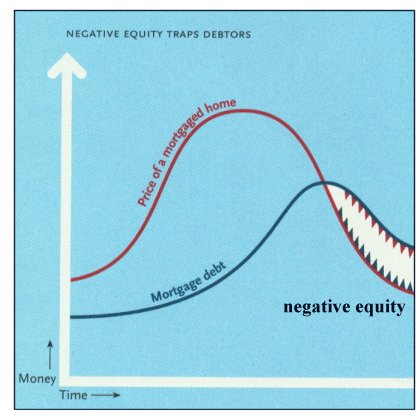 The current issue of Harper's features a lead article entitled "An Illustrated Guide to the Coming Real
Estate Collapse" by Michael Hudson. Here is a precis of the piece.
The current issue of Harper's features a lead article entitled "An Illustrated Guide to the Coming Real
Estate Collapse" by Michael Hudson. Here is a precis of the piece.
Thanks to Marinite, proprietor of the Marin Real Estate Bubble blog, I read a lengthy 2003 interview of economist Michael Hudson on Alexander Cockburn's always-provocative website Counterpunch: The Coming Financial Reality. Hudson is a big-picture guy with a non-standard view of our economic system and the housing bubble. Hudson identifies several key points in all great speculative bubbles: a government which fosters the conditions for a bubble, and a speculative mindset which eschews actual investment for "making money with money." Referring to the classic South Seas Stock Bubble, he says: Every stock market bubble in history, starting with the South Sea and Mississippi bubbles in the 1710s in Britain and France, has been sponsored by government. The driving force has been the government's attempt to cope with debt obligations beyond its foreseeable ability to pay. Creating a bubble has been a way to solve their public debt problem--and to pay off political insiders at the same time, thereby killing two birds with one stone.Hudson makes many other fascinating points in the interview, but for now, let's focus on the connection to the housing bubble. What can be gleaned from his analysis? 
Here is a list of the article's 20 illustrated points: This is the conclusion to the great housing bubble Hudson foresees: millions of indebted households paying interest on mortgages which are greater than the value of their homes. The interest will be collected by a new "rentier" class of mortgage holders who are not even capitalists, in the sense that they are not creating value or wealth with their capital and knowledge, but living off the "new serfs" who will struggle for decades to pay off their massive mortgages. Bleak, it's true--especially if it turns out to be true. May 8, 2006 Housing Bubble Bust Will Take Down the Global Economy The U.S. housing bubble deflating will take down the global economy. Here's how. 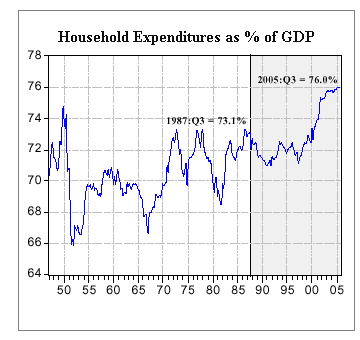
1. The U.S. economy consists largely of consumer spending. The level of this dependence is unprecedented. (see chart to right) As consumer spending goes, so goes the economy. The last time the economy was even close to being so dependent on consumer spending was 1950. After World War Two ended, the demand which had been pent up during the war years, when civilian production had been curtailed in order to manufacture war materials, was finally unleashed. As defense spending fell, consumer spending rose. Now the demand stems not from needs being unmet but from cascades of "cheap money" borrowed from home equity. (see below) 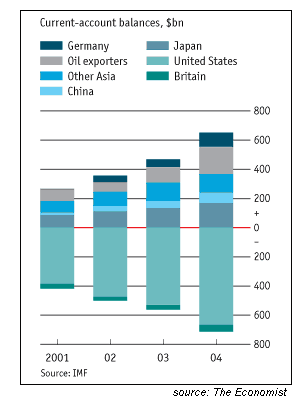 2. The global economy is heavily dependent on the U.S. consumer. As this chart shows, every major
economy runs a current account surplus, i.e. trade surplus, with the exception of Britain,
which has a modest trade deficit. But fundamentally, the U.S. offsets all these surpluses with
a truly massive trade deficit. In other words, U.S. consumers buy all our trading
partners' surplus production. If the
U.S. consumer stops buying, these trade surpluses vanish and these nations slip into recession.
2. The global economy is heavily dependent on the U.S. consumer. As this chart shows, every major
economy runs a current account surplus, i.e. trade surplus, with the exception of Britain,
which has a modest trade deficit. But fundamentally, the U.S. offsets all these surpluses with
a truly massive trade deficit. In other words, U.S. consumers buy all our trading
partners' surplus production. If the
U.S. consumer stops buying, these trade surpluses vanish and these nations slip into recession.
While some wishful-thinking pundits claim domestic demand can make up for faltering U.S. demand, I think the sheer size of the U.S. deficit gives the lie to such hopes. It is currently running at over $800 billion a year--a staggering amount which smaller economies cannot possibly replace. (Recall that the U.S. economy dwarfs all others). 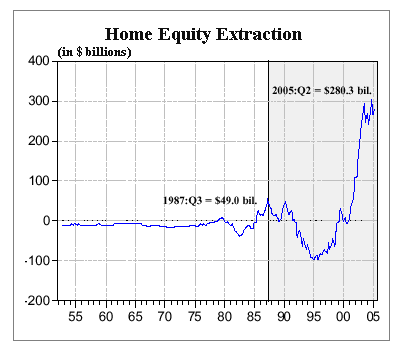 3. U.S. consumers have financed this vast spending spree by borrowing
stupendous quantities of money from their home equity. As the chart reveals, Americans'
home equity actually rose in the 1990s. (Since this graph displays extraction of equity
rather than growth of equity, the -$100 billion notched in 1995 means that homeowners "extracted"
a negative number--that is, their equity rose by $100 billion.)
3. U.S. consumers have financed this vast spending spree by borrowing
stupendous quantities of money from their home equity. As the chart reveals, Americans'
home equity actually rose in the 1990s. (Since this graph displays extraction of equity
rather than growth of equity, the -$100 billion notched in 1995 means that homeowners "extracted"
a negative number--that is, their equity rose by $100 billion.)
As you can see, homeowners have been withdrawing equity from their homes at an unprecedented rate for the past few years--a fact I documented in my May 2 entry, "Housing Wealth Effect Shifts into Reverse." Here's how much money has been extracted from home equity since 2000--about $2.5 trillion: 2000 | $204 bil. 2001 | 262 bil. 2002 | 398 bil. 2003 | 439 bil. 2004 | 599 bil. 2005 | 751 bil. 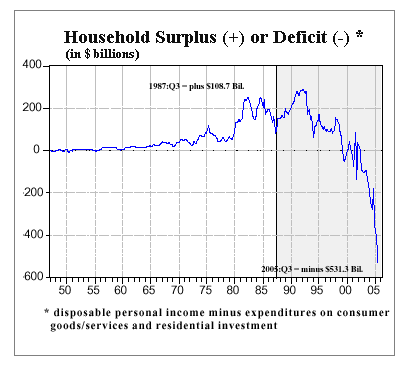 4. U.S. consumers are spending far more than they earn ( i.e. disposable
personal income.) This reliance on borrowed money for household spending is unprecedented.
4. U.S. consumers are spending far more than they earn ( i.e. disposable
personal income.) This reliance on borrowed money for household spending is unprecedented.
It's difficult not to be staggered by this chart, which shows that U.S. consumers are spending hundreds of billions in excess of their actual earnings. The connection between this chart and the preceding ones is obvious: Americans have extracted vast sums from their home equity and spent it in the global marketplace, creating mind-bogglingly massive trade deficits with other nations. 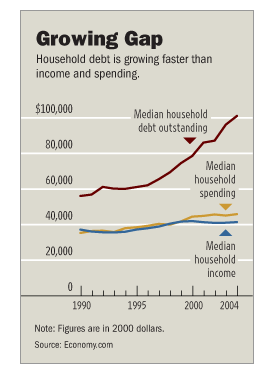 5. Is this unprecedented borrowing and deficit spending sustainable? We all know the answer is no.
Clearly, this enormous debt machine is entirely dependent on the continuing rise of home
equity. Now that home prices have leveled off or dropped, U.S. homeowners
can no longer count on heady increases of equity to fund their future borrowing.
5. Is this unprecedented borrowing and deficit spending sustainable? We all know the answer is no.
Clearly, this enormous debt machine is entirely dependent on the continuing rise of home
equity. Now that home prices have leveled off or dropped, U.S. homeowners
can no longer count on heady increases of equity to fund their future borrowing.
6. Housing need not drop precipitously to cause a precipitous drop in home equity extraction. House prices need only stop rising to cut off the incredibly vast flow of borrowing/home equity extraction. (Rising interest rates will also help to staunch the flow.) 7. Once this monumental extraction of equity dries up, so will consumer spending. As you can see on this chart, wages have been basically flat since 2000. Therefore, consumer spending cannot be attributed to wage increases; it can only be attributed to this equity extraction. Once that dries up, consumer spending will drop significantly: by roughly $600 billion a year, or 5% of the entire U.S. GDP. This would return consumer spending as a percentage of the GDP to levels which are more in line with recent history. 8. Once U.S. consumer spending plummets, our global trading partners will immediately feel the pinch. Once their export sales and earnings drop, their economies will slide into recession. (Recall that exports are a much larger share of their economies than they are in the U.S. economy). Noted economist Martin Feldstein draws the same conclusion in the current issue of Foreign Affairs: The Return of U.S. Savings. The links of the chain cannot be denied; as the U.S. housing market rolls over into decline, it will take home equity borrowing with it, which in turn will take the U.S. economy and thus the world economy down into a prolonged recession. Skeptical? Watch what happens in October 2006. May 6, 2006 Is the Stock Market on the Same Planet as the Economy? Obviously Not With the Dow Jones Industrial Average flirting ever so charmingly with its all-time high-- Go team, go! Rah rah rah!--I have to wonder: is the stock market on the same planet as the real economy? Obviously not. 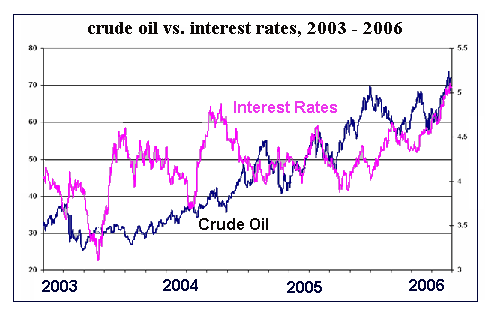
* * * * * * * * * * * * * * * * * * Since when are rising energy prices and interest rates good for business? Since never. Rising oil costs seep into every crevice of the economy, forcing businesses to either raise prices or make less profit--neither one being positive for customers or the bottom line. Ditto for rising interest rates: they squeeze everyone's customers and saddle businesses with higher borrowing costs. Oil and interest rates are rising, the dollar is falling, the housing boom is rolling over--and yet the stock market hits a 6-year high. What planet are buyers of stocks on? Certainly not this one. The rah-rah cheerleaders like to say that markets always rise when the Fed stops raising interest rates, but this is wishful thinking. As rising energy prices infiltrate the cost of transporting goods--i.e., virtually everything consumers and businesses buy--everyone has less money to spend on other stuff (i.e. discretionary spending). As interest rates rise, everyone with adjustable rate mortgages and/or credit cards pays more--as will all the people rushing to change their adjustable-rate mortgages into fixed-rate ones. So how is beggaring every customer good for business? It isn't. The next delusion chanted by the rah-rah crowd is that business spending will take up all the slack as indebted consumers cut back spending. There's one little problem with that scenario. What moron builds up his production and inventory just as his customers are cutting back spending? This makes absolutely no business sense. My customers will be spending less, so I'll sink billions into new software, plant, workers and inventory. Yes, I will if I want to destroy my business. Otherwise, I'll pare expenses and watch my sales very very closely. Here's the real reason for the stock market's fairyland climb: Bubble follows bubble follows bubble. As the Dot-com stock bubble expired, dropping the NASDAQ from 5,300 to 1,100, the psychology of the Free Lunch--money for nothing but playing with money--transferred seamlessly to the real estate market, driving it to unprecedented classic-bubble heights. As this "free lunch money" (all $2.5 trillion of it) gushed into homeowner's pockets, about 2/3 was spent (according to Fed estimates cited in previous entries) but some flowed into other investments such as the resurgent stock market. Bubble follows bubble follows bubble. Borrowed money has also been flowing into precious metals, art, you name it: every asset class is now in a bubble, thanks to the trillions released by super-low interest rates and unlimited liquidity/low credit standards. Market technical analysts know that "market internals" (advance-decline lines, number of new lows to new highs, volume, etc.) have been deteriorating for months. This deterioration has been masked by the rising index numbers; but the "health" of the advance as measured by technical indicators is akin to the racing heartbeat of the cardiac patient on the treadmill. Boy, his pulse is rising very healthily--until his over-worked, unhealthy heart blows a gasket. Cynical chart watchers like me suspect another force is at work--the sucker's rally. It works like this. "Smart money" (hedge funds and other institutional players with billions in hot money) bids the stock market up by buying the heaviest-weighted index stocks--the large-cap stocks like Exxon, Microsoft, GE, etc.--which goose the indices up regardless of how well the smaller companies are faring. Then, once the "retail trade" (i.e. us poor dumb small-fry with our IRAs and 401Ks) buy into the "rally" and start buying, the "smart money" sells their shares at the top and awaits the inevitable roll-over and decline. The Fed meets on May 10. Mark your calendar: May 11 the decline starts and then rapidly picks up velocity. The "smart money" has been exiting all month while the con was set. Reality has a nasty habit of trumping wishful thinking--or a smart con. May 5, 2006 Friday Quiz: Where Is This? Part 4 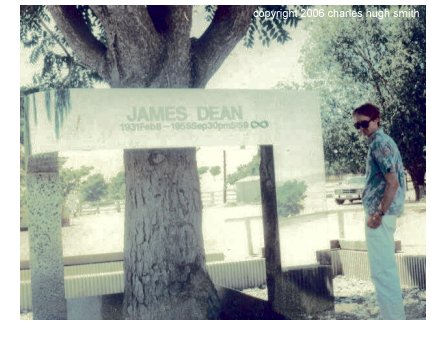
This week's entry is a memorial to an American Immortal, anti-hero/ rebel James Dean. But where is it? Naturally, the two young mavericks in my novel I-State Lines, Daz and Alex, guide their gloriously patched together '62 Dodge Lancer to this hallowed spot. The appeal of James Dean is, I believe, embedded in the mythic nature of his American Identity; his few roles were so iconic that he became much more than a promising young actor. In both Rebel Without a Cause Dean is also Everyman in the films, a "regular guy" whom we can identify with, and a Searcher, a seeker of some meaning beyond the confines of the narrow lives endured by those around him. It is truly amazing to see Dean swagger onstage as the rich but deeply uncomfortable oil tycoon in Giant, drunk to the point of inhibitions lost, boiling over with a powerful mix of resentment, pride and flickering spark of moral outrage. Like Dean's characters, Daz and Alex are also Everymen, Innocents, Explorers and Rebels, anti-heroes in the classic American mode of establshing an unbending independence, but also heroes in their awareness of, and sacrifices for, those around them. I'll ship a copy of my book to the first person who identifies this location with some quick description which can't be picked up off the Web, i.e. evidence that they've actually visited this memorial. So email me! May 4, 2006 High Energy Cost Solution Is Close To Home--And Work   In the simplest terms, Jacobs' key insight is that the livability and indeed, the viability
of any neighborhood or city is its diversity--of people, places to go, housing units,
modes of transport--in every aspect of daily life. She saw suburbs as places which have been
stripped bare of all but one type of housing (sprawling single-family dwellings) and one type
of transport (autos). As a result, suburbs are inherently less adapted to human life
than cities. There's very little you can do there except be at home. For everything else, you
have to drive.
In the simplest terms, Jacobs' key insight is that the livability and indeed, the viability
of any neighborhood or city is its diversity--of people, places to go, housing units,
modes of transport--in every aspect of daily life. She saw suburbs as places which have been
stripped bare of all but one type of housing (sprawling single-family dwellings) and one type
of transport (autos). As a result, suburbs are inherently less adapted to human life
than cities. There's very little you can do there except be at home. For everything else, you
have to drive.
And what does ceaseless driving do? It burns irreplaceable petroleum, eats up time in endless commuting and fouls the air. One would think the obvious solution is to rebuild our suburbs so that we needn't drive so much, but instead the focus is not on driving less but on creating higher efficiency vehicles. This is akin to decorating the arrow lodged in your chest so it looks less painful. The goal of New Urbanism is to re-establish diversity in cities and suburbs by building places which invite a diversity of residents, housing types, businesses and ways of getting around. This plan is of the Waterfront District in Hercules, Calif. across the Bay from San Francisco. It is a New Urbanist development worth examining, for it aggregates small owner-occupied businesses, retail, single family homes and some apartments all within walking (or biking) distance of each other. It occupies a bayfront site adjacent to a rail line and recreational open space. (I have written several articles about Hercules in the San Francisco Chronicle.)  The single most promising method of cutting commutes and driving time is to position
housing and work places close together. This common-sense concept is called Workforce Housing,
and perhaps the best way to achieve it is to build housing and mixed-use retail around and
within the massive parking lots surrounding business parks. For an example, take a look at
the project illustrated on the right,
Duany Plater-Zyberk's plan for an aging business park near Washington, D.C.
The single most promising method of cutting commutes and driving time is to position
housing and work places close together. This common-sense concept is called Workforce Housing,
and perhaps the best way to achieve it is to build housing and mixed-use retail around and
within the massive parking lots surrounding business parks. For an example, take a look at
the project illustrated on the right,
Duany Plater-Zyberk's plan for an aging business park near Washington, D.C.
For a nuanced and insightful look at the entire concept of modernity and how it has shaped our cities, I reecommend Marshall Berman's All That Is Solid Melts into Air : The Experience of Modernity May 3, 2006 Housing Bubble Books 
Regardless of their other strengths and weakneses, all these books have remarkably self-explanatory titles. I reckon you could do pretty well with a volume (an extremely succinct one) which combined these titles into one: One Thing You Can Do To Protect Your Most Valuable Investment: Sell Now! While I can't recommend these books because I haven't read them, I can recommend two works on the housing bubble. The first is a classic text on investment bubbles which was recently updated to address the housing bubble: Irrational Exuberance My second recommendation is for a small ebook, i.e. one you order and download online. Like many other readers, I am skeptical of self-published works and books from small publishers; as in, if this was any good, why isn't it published by a major publisher, praised by a major publication, and written by a famous authority? But as a new author myself (my first novel I-State Lines is being released next week), I also have a soft spot for self-published and small-publisher books because I know how difficult it is to get your work accepted by a corporate publisher, and how difficult it is once you do get it published to get it reviewed or even noticed in our crazy-busy, media-saturated world. It's easy to recommend a book which has already received oodles of praise from the mainstream press, and hard to sort through smaller, lesser known works. There's another mechanism at work as well, one which has been tested occasionally over the years: if the author is already famous, then his/her work is automatically accepted as golden even if it's garbage, while actual literary masters' works (think Nabokov, Faulkner, Proust, Austin) get rejected as inferior when passed around as "new" work by "new" writers. The only way to make a fair assessment is to be a critical reader of everything equally, which is always my goal. And we all know that most of what gets praised to the skies in the media turns out to be merely OK upon close inspection. For a succinct overview of the current housing bubble and its causes, The single best text I've found is the ebook How To Prosper In The Changing Real Estate Market. I have emailed my positive views to the author, and he has seen fit to post my comments on his webpage (with my permission). I don't get a commission or remuneration of any kind from the author or publisher; I just think he's assembled a thorough, easy-to-read and well-documented report which supports the thesis that this is truly a bubble of epic proportions. This ebook would be something you could send to a bubble skeptic whom you are trying to warn for their own good, as they will have a hard time refuting the data. It's also short (70+ pages), so anyone can read through it in an afternoon. The "special reports" on gold and foreign currencies are very brief and not much to go on (an opinion I also shared with the author), and the marketing presentation is a bit of an oversell to my taste, but the ebook is an excellent read, especially for those who don't pore over economic reports for fun like some of us. It cogently covers all the topics you'd address if you were trying to convince a friend to sell (or at least not to buy). One would hope bubble skeptics would change their minds after absorbing these two texts, but the grip of euphoric manias is strong indeed. If you doubt this, ask yourself how many analysts predicted Sun Microsystems would drop to $3 when it was $60. The answer, to the best of my knowledge, is a big fat zero. May 2, 2006 Housing Wealth Effect Shifts Into Reverse  Everybody loves the Wealth Effect on the way up, but they forget that it also has a reverse
gear. We're about to rediscover that the Wealth Effect works just as well on the way down.
Everybody loves the Wealth Effect on the way up, but they forget that it also has a reverse
gear. We're about to rediscover that the Wealth Effect works just as well on the way down.
What's the Wealth Effect? Let's turn to the eerily familiar Bubble-topping month of December 1999 and the tireless rah-rah cheerleaders at BusinessWeek for an explanation: One theory economists are revisiting to help them understand the market's clout is the "wealth effect" that Nobel Prize winner Franco Modigliani postulated in the 1950s. Simplistically, his idea was that if wealth increases, people buy more; if it decreases, they buy less. If they buy a lot less, you get a recession, or worse. Modigliani's research showed that for every $1 of new wealth, people spend about five cents more and vice-versa. Ludvigson and Steindel's New York Fed study pegs the effect at three to four cents per dollar gained or lost. That sounds small, but figured on $10 trillion in U.S. household investments, it's $300 billion to $400 billion -- spending that could depress the economy if it suddenly disappeared.And disappear it did--and lo and behold, the nation did indeed slip into recession, albeit ever so briefly, as the mighty Federal Reserve lowered interest rates to 1% and cranked up the money machine. Other U.S. agencies did their bit as well by lowering credit standards so anyone with a job could get a mortgage without a down payment or even an application review. As noted here recently, according to the FDIC, only 74% of Americans have incomes above the poverty line, and 69.1% own a house. (The remaining 5% probably live in absurdly unaffordable locales like California which precludes them from buying.) All that easy credit, plentiful money, low interest rates--surprise--created a housing boom. No one is more delighted with the Wealth Effect than Realtors, of course, who are more than pleased to trumpet the fantastic money-machine created by rising home values: Housing Wealth Has Greater Effect Than Stocks, New Study Shows. To summarize: stocks rise and fall over relatively short periods of time, and hence the Wealth Effect is smaller than that created by housing, which rises and falls in much longer cycles. (Only the Realtors' report didn't mention that housing can fall. That would be akin to Galileo whispering under his breath, "But the Earth does orbit the Sun" while facing the Inquisition.) The Realtors' report also made rather smug mention of the fact that housing wealth is less concentrated than stock and bond wealth--a good point which we'll cover later. Other tidbits from the report include: 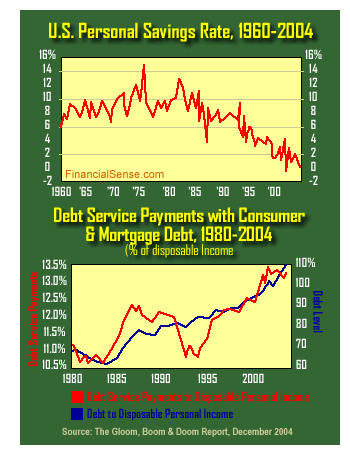
According to the FDIC, In the first six years of this decade, the net increase of household wealth has been $5 trillion. Given the chart and data above, it is clear that the vast majority of that increase came in the form of housing equity. For a snapshot of what the housing Wealth Effect has wrought in the real world, let's turn to Newsweek's recent article entitled So Long to the Wealth Effect? The piece lists the following data on how much money has been pulled out of that newly minted housing wealth via re-financing or home equity lines of credit. (This is from the Federal Reserve, except for the 2005 estimate which comes from the FDIC.) YEAR | MONEY | SHARE OF DISPOSABLE PERSONAL INCOME 2000 | $204 bil. | 2.8% 2001 | 262 bil. | 3.5% 2002 | 398 bil. | 5.1% 2003 | 439 bil. | 5.4% 2004 | 599 bil. | 6.9% 2005 | 600 bil. (FDIC est.)($751 billion, US News & World Report )  Add this up and it seems Americans have pulled about $2.5 trillion out of their homes
in a mere five years--virtually half of the entire bubblicious rise in household assets.
According to the article, the Fed estimates that 2/3 or so of
this stupendous sum was spent. So let's say $2 trillion was spent (think drunken sailors
wandering through the inexplicable aisles of Ikea, etc.). That's a significant
percentage of consumer spending, and a significant drawdown on home equity.
Add this up and it seems Americans have pulled about $2.5 trillion out of their homes
in a mere five years--virtually half of the entire bubblicious rise in household assets.
According to the article, the Fed estimates that 2/3 or so of
this stupendous sum was spent. So let's say $2 trillion was spent (think drunken sailors
wandering through the inexplicable aisles of Ikea, etc.). That's a significant
percentage of consumer spending, and a significant drawdown on home equity.
Home equity now accounts for 38% of the average household’s net worth—up from 27% in 2000. This means that the wealth of most American households is now concentrated in their homes. But using "average houshold" is deceptive, for in reality the vast majority of assets are held by the top 10% of households, while the bottom 50% have virtually no wealth. Let's turn to the august Wall Street Journal for Wealthiest American Families Add To Their Share of U.S. Net Worth: The top 1% held 33.4% of the nation's net worth in 2004, up from 32.7% in 2001, but still lower than a peak of 34.6% in 1995. In 2004, the wealthiest 1 percent owned 70% of bonds, 51% of stocks and 62.3% of business assets.  So the top 10% of households own 70% of the nation's entire assets and the bottom 50% own
2.5%. The vast majority of the stocks and bonds are held by the top 10%. This is important,
because the rah-rah cheerleaders like to say that 50% of American families have
a stake in the stock market. What they fail to mention is the stake is roughly equivalent
to a $5 chip on a Las Vegas table with a $100 minimum bet.
So the top 10% of households own 70% of the nation's entire assets and the bottom 50% own
2.5%. The vast majority of the stocks and bonds are held by the top 10%. This is important,
because the rah-rah cheerleaders like to say that 50% of American families have
a stake in the stock market. What they fail to mention is the stake is roughly equivalent
to a $5 chip on a Las Vegas table with a $100 minimum bet.
In other words, the Wealth Effect of the recovered stock market is completely overestimated. Diane Swonk, deputy chief economist at Bank One in Chicago, argues that the stock market is "not a dominant factor and is very hard to use as a faucet you turn on and off. 52.2% of households don't have a dime" in the stock market, said Swonk.Here is the devastating conclusion which this data leads to: 70% of American households own a home, but 50% of households have virtually no wealth. What does that mean? It means 20% of homeowners are maxed out, borrowed to the hilt, with little or no home equity to their names despite being "homeowners." In fact, they own almost nothing and owe almost everything. Some simple math reveals that about 20 million homeowning households are extremely vulnerable to the reverse Wealth Effect. (75 million homeowners + 33 million renters = 108 million households. 50% of 108 M = 54 M with almost no assets. 54 M - 33 M renters = 21 M homeowners with little if any assets.) What happens to these 20 million homeowners once housing values decline and / or a recession kicks in? With no cushion in home equity or other assets, many will lose their homes. Yesterday, I may have shocked you by concluding that 5 million homes could go into foreclosure. Now, this number seems very conservative. And what happens to the home equity of the "middle class" (the 40% between the poor 50% and the wealthy 10%) when 5 to 10 million homes get sold at foreclosure auction? Their home's value drops like the proverbial stone. And what happens to consumer spending, which has been so heavily dependent on drawdowns of home equity? It too drops like the proverbial stone. That's called the Wealth Effect in reverse. As the above charts reveal, the rise in household assets since 2000 has been a chimera of borrowed money. Real wealth is the surplus capital accumulated by producing more than you consume--in simple terms, savings which are invested in productive assets. A house is not a productive asset, it is shelter and a repository of value only to the degree it can be profitably rented out as shelter. The Realtors--and the rest of us--are about to find out the Wealth Effect works not just on the rise but also on the fall. Scenarios for the Next U.S. Recession (FDIC report, March 23, 2006) Gary North's view of the FDIC report May 1, 2006 How Many Foreclosures Will Hit the Market? 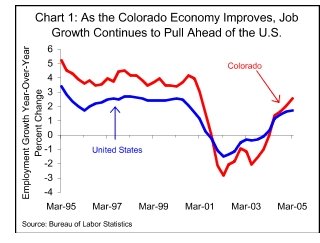 OK people, stay sharp. We're going to thread our way through a lot of housing
statistics and reach a mind-boggling conclusion: 5 million foreclosures,
5 million investment/2nd homes dumped on the market and bank/thrift losses of $500 billion.
Farfetched? Read on.
OK people, stay sharp. We're going to thread our way through a lot of housing
statistics and reach a mind-boggling conclusion: 5 million foreclosures,
5 million investment/2nd homes dumped on the market and bank/thrift losses of $500 billion.
Farfetched? Read on.
First up is housing Bull Michael Youngblood, managing director of asset-backed securities (a.k.a. mortgage-backed securities) at Friedman, Billings Ramsey who states in this week's Barron's: "What dominates the mortgage market is income." In other words, if people have jobs, housing will continue to rise. He goes on to assert that interest-only loans are not more dangerous than fixed-rate mortgages. Leaving aside that Mr. Youngblood earns his living selling "securitized" mortgages (if people stop paying the mortgage, the value of the security plummets--not that you'd hear that from Mr. Youngblood), let's look at his thesis. 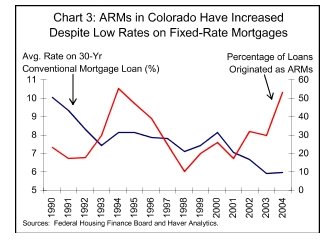 The chart above shows job growth in Colorado to be better than in the nation as a whole
(unemployment is a low 4.7% nationally). Next, look at the chart of
Colorado adjustable-rate mortgages (ARMs). Even as fixed-rate mortgage rates dropped to historic lows,
over 50% of the loans in Colorado were ARMs.
The chart above shows job growth in Colorado to be better than in the nation as a whole
(unemployment is a low 4.7% nationally). Next, look at the chart of
Colorado adjustable-rate mortgages (ARMs). Even as fixed-rate mortgage rates dropped to historic lows,
over 50% of the loans in Colorado were ARMs.
According to Mr. Youngblood, everything should be hunky-dory. But the reality is that foreclosures are skyrocketing in Colorado, and are 3 times higher than the national average; from National Foreclosures Up 63 Percent From a Year Ago: Colorado’s foreclosure rate leapfrogged to highest among the states thanks to a 31 percent increase in new foreclosures from the previous month. The state reported 5,392 properties entering some stage of foreclosure in March, a foreclosure rate of one new foreclosure for every 339 households — more than three times the national average. 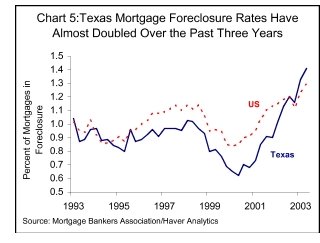 So much for Youngblood's cheery (if baseless) thesis. Here is a state with strong job growth and plentiful
ARMs--and foreclosures are leaping. The stark reality of foreclosures is not isolated
to Colorado, as this chart of Texas foreclosures shows. The situation in Boston is equally
perilous, as reported in the
Homeowners stretched perilously from the
Christian Science Monitor of 3/21/06:
So much for Youngblood's cheery (if baseless) thesis. Here is a state with strong job growth and plentiful
ARMs--and foreclosures are leaping. The stark reality of foreclosures is not isolated
to Colorado, as this chart of Texas foreclosures shows. The situation in Boston is equally
perilous, as reported in the
Homeowners stretched perilously from the
Christian Science Monitor of 3/21/06:
Fully 27.1 percent of Boston's homeowners with a mortgage spent at least half their gross income on housing in 2004, according to the latest census figures available. Those costs, which include utilities and insurance as well as mortgage payments, were more than double the national rate of 11.7 percent and topped New York (25.9 percent), Los Angeles (26.5), San Francisco (20.4), and Chicago (20.3). Of the 25 biggest cities, only Miami had a higher rate (35.8 percent).USA Today chips in with this story on the woes facing the millions of homeowners stuck with ARMs: Some homeowners struggle to keep up with adjustable rates When they refinanced their home two years ago to pay off some bills, Robert, now 78, was working as a deliveryman. But his employer went out of business last April. Now he and Lorraine, 72, a retired nurse, are both seeking work. The rate on their mortgage has jumped from 7% to 10.5%.Hmm, nothing like a little media snooping to pry a fixed-rate mortgage out of the woodwork, eh? This tale reveals how subprime lenders have taken advantage of desperate/ hopeful/ignorant homeowners who are stunned to find their rates rising 3.5% in one bound. Realtors, of course, couldn't be happier selling empty condos and houses by the millions to unwary investors. Second Home Sales Hit Another Record in 2005; Market Share Rises 27.7 percent of all homes purchased in 2005 were for investment and another 12.2 percent were vacation homes. All together, there were 3.34 million second-home sales in 2005, up 16.0 percent from an upwardly revised total of 2.88 million in 2004. The market share of second homes rose from 36.0 percent of transactions in 2004 to 39.9 percent in 2005.As the market softens, investors are finding that they can't dump their units for love nor money. Here is a Washington Post story investors hurting; Doors Close for Real Estate Speculators After Pushing Up Prices, Investors Are Left Holding Too Many Homes. Just for context: according to the National Association of Realtors, There were 7,072,000 existing-home sales in all of 2005, up 4.2 percent from 6,784,000 in 2004. This is the fifth consecutive annual record; NAR began tracking the sales series in 1968. According the U.S. Census Bureau, 1.3 million new homes sold in 2005.The Census Bureau also reports that there are approximately 75 million homeowners in the U.S., and 33 milllion occupied rental units. 
Let's summarize: In a nutshell: in the past 3 years, 10 million people signed ARM mortgages which will reset soon, and 10 million housing units were sold to investors. Foreclosures are already rising, even though job growth is strong and unemployment is low. In addition, 4 million recent homebuyers are subprime risks whose grasp on their homes is tenuous indeed. If 5 million marginal bubble-buyers fold their hands due to ARM resets or job loss, what will that do to the value of those 10 million investment units? Let's say the resulting drop in values causes half of those empty, cash-flow negative units to get dumped on the market (or foreclosed). Who's going to buy these 10 million properties? 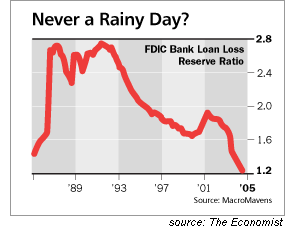
One last chart. Bank reserves--the cash lenders keep to cover "bad loans"--is at an all-time low. That leaves lenders extraordinarily vulnerable to losses should foreclosures rise. The expert quoted above estimated bank and thrift losses of $100 billion should 1 million homes go into foreclosure, so what happens if 5 million properties default? Simple extrapolation suggests losses would exceed $500 billion. Does that sound extreme? Not at all, when you consider that the dot-com bubble bursting erased at least $1 trillion in equity. Compared to that, a mere half-trillion in losses doesn't seem unrealistic. April 29, 2006 The Thin Man: Thoroughly Modern Movies 
Sounds like a script from Oprah's show, doesn't it? Dysfunction, corruption, heavy drinking--it's all here. But the appeal is all in what's not present in today's America. The charmingly natural chemistry between William Powell and Myrna Loy and the sparkling dialog have endeared viewers for decades (as have the antics of their irrepressibly cute dog, Asta) but I have a soft spot for the wonderfully rough-around-the-edges (if not outright seamy) slice of life the films portray: if a suspect mouths off shortly after being collared, he's quickly silenced by a fist in the face (here's yer Miranda rights right here!), and the movies abound with two-bit grifters, gamblers, floozies, shifty characters and ex-cons. Nick Charles has the enviable (and let's face it, wildly improbable) gift of being at ease in both this underworld of human greed, passion and cupidity, and the glittery high-society life the couple inherited from Nora's rich father. One highlight (at least for me) in each film is some accented (Bronx or Brooklyn? I need some guidance here from a New-Yawka) ex-con, who good-naturedly reminds Nick, "Hey, Nick, doncha remember me? Two-bit Charley? Ya sent me up the river, remember? But hey, no hard feelings, you're alright!" Nick, ever so slightly taken aback, nonetheless greets the proletarian ex-con with bonhomie and makes a point of introducing Nora to the ex-con, who inevitably makes a wisecrack along the lines of, "Hey, she's a looker!", allowing Nora to look askance at her all-too-chummy-with-smalltime-hoods husband. The films sport an abundance of class-conscious Depression subtexts. While they enable the audience the escapist pleasures of vicariously sharing the high life of parties, discreet gambling boats and hot jazz clubs, Nick's breezy comfort with lower-class crooks simultaneously inoculates the couple from underclass resentment. You just gotta love Nick, who in classic anti-hero fashion, staves off pressure from both the police and media while giving the hoods who are wrongfully suspected a straight deal. He is, in other words, the personification of noblesse oblige: the embodiment of all the noble characteristics that the nation sought in the privileged class. (The role of film is, after all, to make fantasy real.) Most amazingly, the film takes the old, hackeyed gambit of assembling all the suspects into one room for the hero-detective to pick apart and makes it work, both as drama and as comedy. Beefy cops don ill-fitting waiters outfits and roughly shove recalcitrant suspects into their dining chairs ("You're not gonna pin this on me, copper!" etc.) The fancy dinner-party mis-en-scene sets up one of Nora's best lines: "Waiter, serve the nuts. (pregnant pause). I mean, serve the nuts to the guests." The Thin Man is both the epitome of and the template for sophisticated mystery-comedies, a lighter-than-air souffle of class pretensions deflated, seamy villany exposed and a constantly inebriated anti-hero who nonetheless is sharp as a tack when it comes to nailing the evil-doer or countering his adorable mate's witty barbs. Oh, and the thin man is thin--and so is Nora. Since the couple is always impeccably dressed, it's hard not to notice that they look great. Was this a reflection of starvation diets and punishing workouts, or simply a time before fattening junk food stealthily conquered America? I would peg Nick's BMI (body mass index) at about 22. (Normal is 18.5 to 25.) If you're curious about your own BMI, calculate it here. (and no fibbing; Nick don't approve of no cheating.) Please browse this month's entries and the archived wEssays listed in the sidebar. If nothing here strikes your fancy, skim through my recently published articles (generally in the San Francisco Chronicle) and my archives back to 1995. I would be honored if you link any essay to your website, print a copy for your own use or add my RSS or Atom feed. And of course I appreciate your recommendations of this weblog and your comments: csmith@oftwominds.com. wEssay noun, combination of 'web' and 'essay,' denoting a short online essay which exploits the hyperlinks, interfaces and interactive capabilities of the World Wide Web; coined by Charles Hugh Smith on May 1, 2005, in Berkeley California. copyright © 2006 Charles Hugh Smith. All rights reserved in all media. |
Subscribe via RSS: search my site:
Worth Visiting:
Mish's Global Economic Trend Analysis patrick.net Marin Real Estate Bubble View from Silicon Valley ilind.net PACT America Gold Eagle Econotech myrealestatebubble.com (links to articles and eBook) The Kaleidoscope (indie bookstore, free shipping; buy my novel I-State Lines) |
||
|
Our retail policy: Nothing is for sale except books/films I recommend and my own novel I-State Lines (via links to Amazon.com and The Kaleidoscope: Our Focus Is You independent bookstore) Free alternative: find them at your local library. |
home |